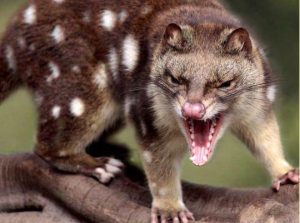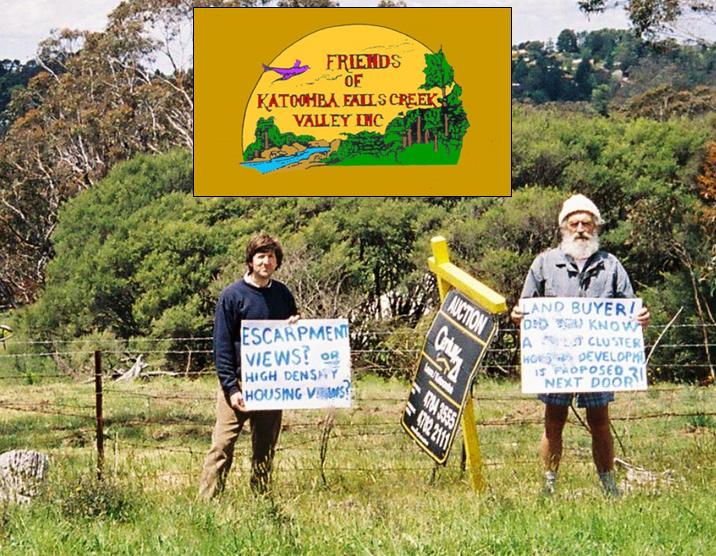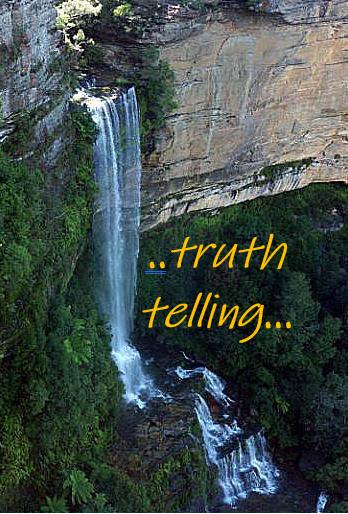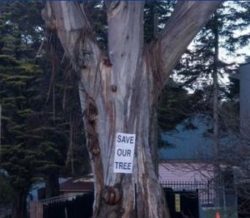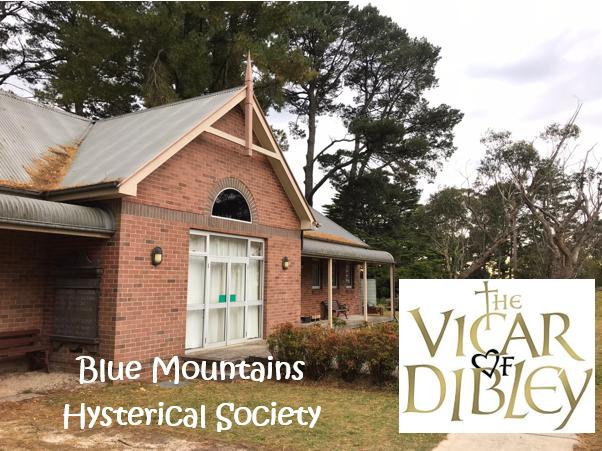Archive for the ‘Habitat Threats’ Category
Wednesday, October 2nd, 2013
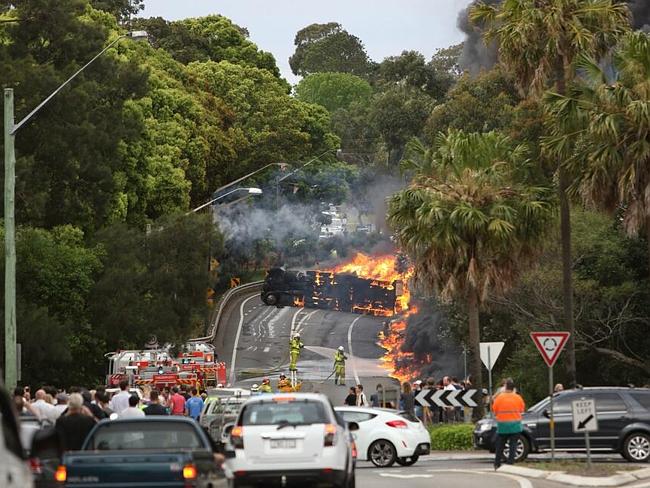 An out of control petrol tanker semi-trailer speeding 80kph down Mona Vale Road rolls and explodes, burning two motorists to death. An out of control petrol tanker semi-trailer speeding 80kph down Mona Vale Road rolls and explodes, burning two motorists to death.
A further six people remain in hospital. The truck was carrying 18,000 litres of fuel when it rolled and erupted into a fireball. Mona Vale in is Sydney’s north.
[Source: The Daily Telegraph, 20131001, ^http://www.adelaidenow.com.au/news/driver-a-8216hero8217-after-runaway-tanker-explodes-in-mona-vale-victims-never-had-a-hope-witnesses-say/story-e6frea6u-1226730998888]
.
The cause is unknown at this stage, but it is the consequence that is the issue, irrespective.
Hardly a day goes past without some news story about a truck crash on a Sydney road and this is compounded across Australia.
Yet in transport policy unison, governments across Australia at state and federal levels have abandoned rail freight and instead are headlong encouraging more and bigger trucks on our roads. They are encouraging larger and long trucks and spending billions to accommodate them. Road making has become governments’ panacea for solving linehaul freight challenges. The numbers of trucks on local, suburban and regional roads across Australia must have doubled in the past decade or so.
At the same time, both levels of government have been lax for decades to ensure high standards of heavy vehicles and the professional competency of truck drivers. Australian trucking has become a cowboy game plagued by industry cost cutting and unreasonable delivery expectations. The industry’s problems compound down to the truckie.
Truck drivers across Australia are no longer paid a fair hourly rate for their work, but have been reduced to being paid by a minimalist ‘trip rate’. So the more trips they do, the more they get paid. Overnight linehaul trucking is a ticking time bomb.
Truck drivers across Australia more often than not are no longer paid employees who are professionally trained by their employers. They are typically owner driver sub contractors with a massive bank mortgage tied to the truck or prime mover they own. They only get paid by the runs they do and have all the burden of maintenance, repairs, insurance and loan repayments. That is before paying themselves a wage. Forget leave and superannuation.
Trucking industry professionalism is out the door. Anyone can get a truck licence. The concept of trucking being a profession in Australia in the days of TNT and Mayne Nickless has long become a distant memory. It is a mugs game now.
Truck drivers, motorists and roadside communities are the victims of dumbed down bad government transport policy. The only ones who are benefiting from cheap dumbed down trucking are the trucking magnates and their corporate retail clients. The politicians save money building trucking roads instead of big picture rail and integrated multimodal logistics. But roads for trucks is short term thinking. It is a policy that has ignored road users’ rights to expect the highest standards of road safety.
Australia’s trucking regime is sapping billions for faster and wider roads instead of long term investment in freight rail,just like their doing to the Great Western Highway to freight produce and goods across the continent. It’s to hell with the local communities they rip up along the way. It’s to hell with the native habitat they rip up to build wider and new trucking expressways. When fuel and toxic chemicals spill from overturned trucks, it’s to hell with the downstream environment.
More roadside communities are increasing exposed to the risk of deadly speeding trucks, and people are dying as a result.
.
 Safety First
Residents of the roadside community of Woodford in the Blue Mountains west of Sydney protest over losing their pedestrian crossing so that trucks can cruise nudging 90kph through their village. [Photo by Jodi McConaghy, 20130608] Safety First
Residents of the roadside community of Woodford in the Blue Mountains west of Sydney protest over losing their pedestrian crossing so that trucks can cruise nudging 90kph through their village. [Photo by Jodi McConaghy, 20130608]
.
The NSW Government’s RTA-come-RMS (roads authority) has “ripped the heart” out of Woodford.
Woodford Progress Association spokesman Ian Robinson told 100 residents in a protest rally last June that Woodford was “once known as the heart of the Mountains but the RMS has ripped the heart right out of our town”. Mr Robinson says the current plans leaves the elderly stranded, splits the town in two and forces school children to make a large detour to get to their bus stop, he said.
“Without lights across the highway within the vicinity of the Woodford Academy, not only children, but also residents and fire brigade volunteers on the north side are cut off from south side neighbours [and] the elderly … are stranded in their own village,” he said.
The truck-centric civil engineers with the RTA-come-RMS expect local residents to take a two kilometre detour to use the pedestrian bridge at Woodford railway station.
Mr Robinson said:
“They also now tell us that they do not regard Woodford as a ‘town’ and that they want to run four lanes of traffic at 80 km/hr right through the heart of Woodford.”
Cheap but dangerous seagull intersections are to be built in the centre of the new wider trucking expressway between massive trucks doing 90kph down the hill through Woodford.
A third resident petition to the NSW Roads Minister has again been ignored. It’s all about trucks with the politicians.
(Former) councillor Geordie Williamson, a Woodford resident, says the plan also threatens the lives of the 2500 Woodford residents.
“The very least RMS can do is grant residents a safe means of crossing the newly-widened highway. Failing to do so will virtually guarantee injury or loss of life in the years to come,” Clr Williamson said. “The highway should not only be designed to massage the bottom line of freight haulage companies.”
[Source: ‘Woodford fights for safer passage’, 20130620, by B. C Lewis, Blue Mountaisn Gazette, ^http://www.bluemountainsgazette.com.au/story/1585708/woodford-fights-for-safer-passage/]
.
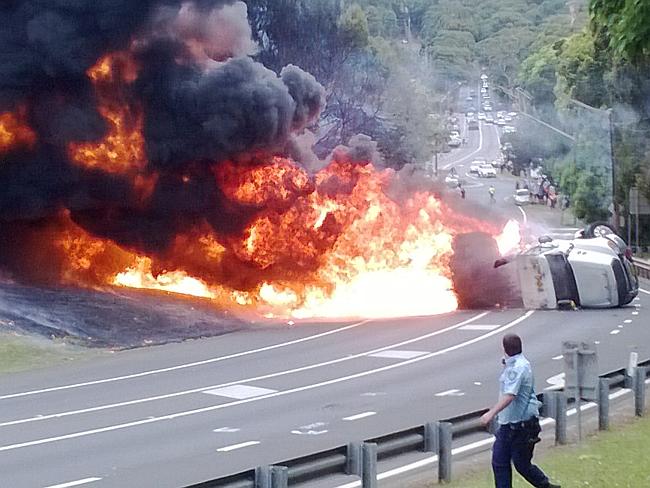 The Mona Vale Road trucking experience
Coming to a roadside community near you. The Mona Vale Road trucking experience
Coming to a roadside community near you.
.
Footnote
.
Government belatedly issues Cootes Transport with 126 Defect Notices
.
 . .
<< Police believe mechanical problems are the most likely cause of the fatal crash involving the Cootes Transport petrol tanker since the out-of-control fuel tanker ploughed into a power pole and four cars before erupting in a fireball on Mona Vale Road.
A Mr Shane Day has been identified as the driver of the petrol tanker, who works for Cootes Transport. It is not clear if he is an employee or a contractor, but industry probability would like be the latter and not paid by Cootes by the hour.
So two men were burnt alive when this Cootes petrol tanker lost control on Mona Vale Road at Mona Vale about 3:40pm (AEST) yesterday. Police say the dead men are a 71-year-old local and a man in his 60s from interstate. Both men were travelling in the same car, when this trucking wall of death bore down upon them.
Assistant Police Commissioner John Hartley:
“It certainly looks like they were killed at the scene by the fire rather than the crash itself.”
They were burnt alive.
Twelve trucks operated by Cootes Transport have been taken off the road. Inspectors from the New South Wales Government’s Roads and Maritime Services have subsequently inspected more than 80 Cootes Transport trucks at checking stations in Sydney and Newcastle late this afternoon. The company has been issued with 26 defect notices and 12 trucks have been taken off the road.
[Ed: A belated slap on the wrist for purported negligence causing two men to burn to death, just to pacify the media and political fallout. Government reactive and random monitoring of safety is negligent cost cutting and so life costing. At no time should unroadworthy trucks be in service. At no time should unprofessional heavy vehicle drivers be behind the wheel. It must cost more, and so be it. Next week as the media interest fades, it’ll be government trucking as usual and billion dollar truck magnate profit as usual].
.
Mr Hartley:
“We’re investigating a number of factors that may have contributed to the crash but at this stage we’re looking at the possibility of mechanical failure on the truck itself. That’s probably the most important lead we have at this stage. The vehicle needs to be fully examined properly. At the end of the day we’ll find that something quite simple such as mechanical failure or a mistake by the driver has caused these fatal consequences.”
.
Meanwhile, the toxic spill caused by a fuel tanker’s 18,000 litres of petrol from the exploded tanker has flooded and contaminated surrounding waterways and bushland.
A mix of fuel and fire retardant has leaked into the surrounding waterways for at least a 1.5 kilometre radius.
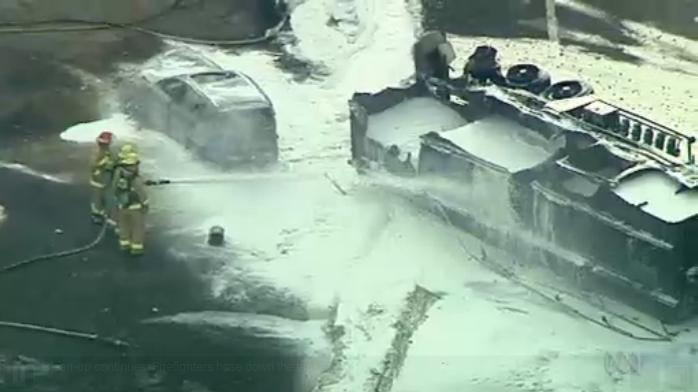 A toxic mix of 18,000 litres of petrol and fire retardant polluting surrounding waterways.
Without trucks Australia may stop, but with the current trucking mentality people are dying, like the two men burnt to death in the above car.
(Source: ABC News) A toxic mix of 18,000 litres of petrol and fire retardant polluting surrounding waterways.
Without trucks Australia may stop, but with the current trucking mentality people are dying, like the two men burnt to death in the above car.
(Source: ABC News)
.
NSW Fire Brigade Superintendent Ian Krimmer:
“It is a big operation to clean up the leaking fuel which has seeped into drains and waterways at Mona Vale. We’re placing sand in a number of those drains to contain the fuel spillage,” he said. It’s still unknown how much fuel has leaked into those drains. It could take several days to mop up and clean up that particular situation.”
.
 With Trucks Australia Stops With Trucks Australia Stops
.
[Sources: ‘Cootes trucks taken off the road after fatal tanker explosion in Mona Vale’, 20131002, ^http://www.abc.net.au/news/2013-10-02/mechanical-failure-suspected-cause-of-tanker-explosion/4994502; ‘Truck driver’s name revealed’, 20131004, ^http://www.dailyadvertiser.com.au/story/1819612/truck-drivers-name-revealed/?cs=332; ‘Toxic spill clean-up continues after fatal tanker crash at Mona Vale in Sydney’s north’, 20131002, ^http://www.abc.net.au/news/2013-10-01/two-dead-in-fuel-tanker-crash-in-sydney27s-north/4991974]
.
Tags: fuel and toxic chemicals, Great Western Highway, Mona Vale Road, overnight linehaul trucking, Petrol Tanker Crash, professional trucking, Roads and Maritime Services, RTA, RTA-come-RMS, speeding semi trailer, truck spills, trucking expressway, With Trucks Australia Stops, Without Trucks Australia Stops, Woodford pedestrian lights
Posted in Threats from Road Making | No Comments »
Add this post to Del.icio.us - Digg
Monday, September 30th, 2013
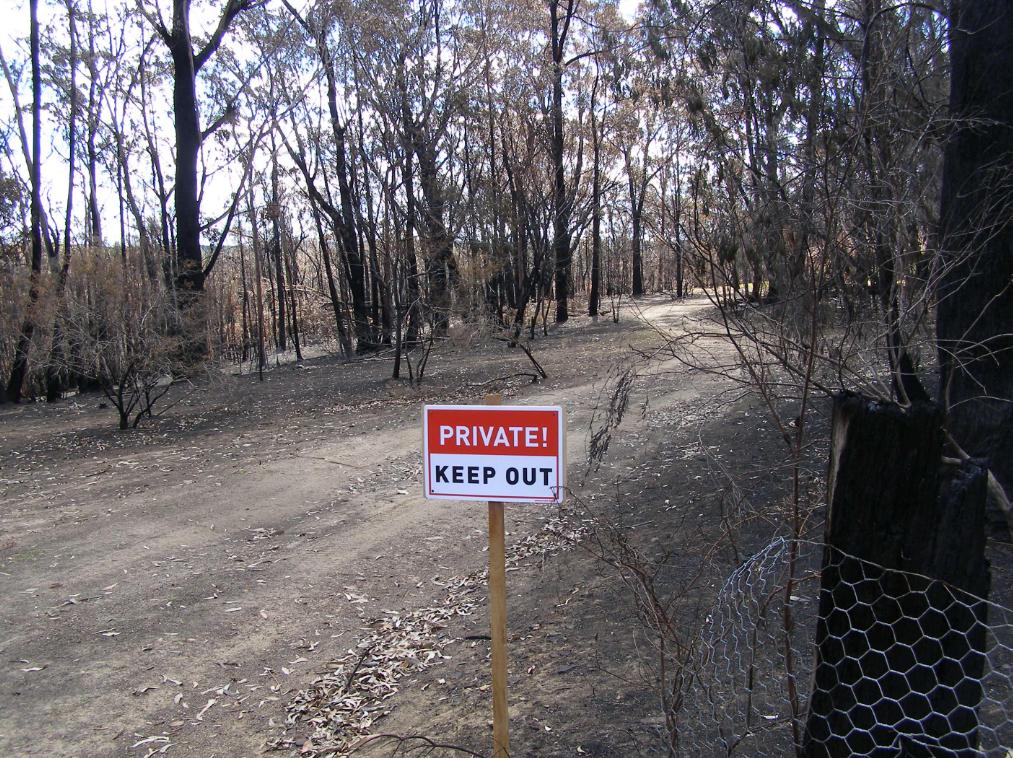 Hawkesbury Heights hazard reduction negligence
Well our fire “escaped”. Sorry, we’re immune from prosecution. Hawkesbury Heights hazard reduction negligence
Well our fire “escaped”. Sorry, we’re immune from prosecution.
[Photo by our Investigator along Hawkesbury Road, Blue Mountains, Australia, 20130921, photo © under ^Creative Commons]
.
Partners in crime: big ego Blue Mountains National Parks with even bigger ego Blue Mountains RFS, have jointly stuffed up big this time.
.
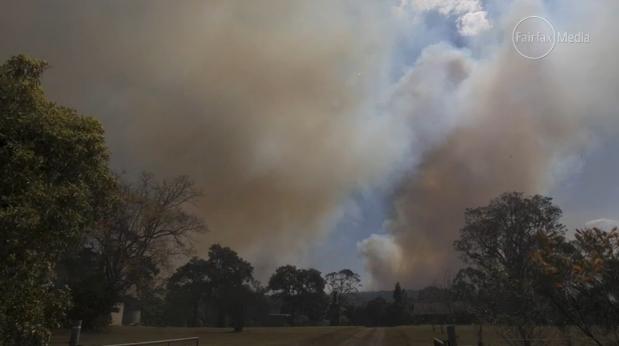 A hazard reduction north of the Hawkesbury Road from the previous weekend was left abandoned.
A few days later the forecast wind picked up and voila: HR come wildfire. Woops.
Sound familiar? Warrumbungles (2013), Macleay River (2012), Grose Valley (2006), Canberra Firestorm (2003) A hazard reduction north of the Hawkesbury Road from the previous weekend was left abandoned.
A few days later the forecast wind picked up and voila: HR come wildfire. Woops.
Sound familiar? Warrumbungles (2013), Macleay River (2012), Grose Valley (2006), Canberra Firestorm (2003)
[Source: Fairfax, ^http://www.smh.com.au/nsw/hazard-reduction-burn-started-major-sydney-bushfire-20130913-2tois.html]
.
Hawkesbury Heights residents will recall last year’s escaped hazard reduction along the Springwood Ridge inside the Blue Mountains National Park. It was left for few days, then the forecast prevailing sou’wester picked up on 30th August 2012. The fire jumped containment lines then threatened the Bowen Mountain community to the nor’ east.
<<More than 30 firefighters from the NSW Rural Fire Service and National Parks and Wildlife Service have worked behind homes in the community of Bowen Mountain to contain this fire. Crews backburned to establish containment lines around the fire with the assistance of helicopters and earth moving machinery.>>
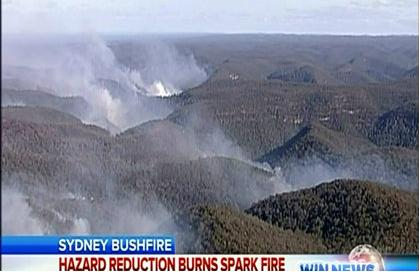 National Park ablaze thanks to government-sanctioned arson National Park ablaze thanks to government-sanctioned arson
[Source: Blue Mountains RFS, ^ http://www.bluemountains.rfs.nsw.gov.au/dsp_more_info_latest.cfm?CON_ID=18199, Reference will probably disappear within days of publication.]
How much did that stuff up cost? This is where donations to the RFS are going.
The Habitat Advocate reconstructs that the HR folly at Hawkesbury Heights two weeks ago probably unfolded as follows:
Blue Mountains National Parks decides that its a good idea to set fire to the Blue Mountains National Park along Shaws Ridge. Shaws Ridge is over two kilometres from the Hawkesbury Road. It has nothing to do with ‘asset protection’ to private properties. So the Parks Service just calls it ‘strategic’ or an ‘ecological burn’ – good for the bush.
“Generally over an 8-12 year cycle it [vegetation] needs to be burnt, which allows it to regenerate.” ~ Blue Mountains RFS district manager David Jones, 20130918.
The bush and its wildlife likes being burnt. Parks Service’s gospel Fire Maps shows in bright red that this part of the protected Blue Mountains National Park (World Heritage Area) hasn’t been burnt for 8 years, so it must to be burned, just in case it burns!
So the fire cult’s mindset is fixated. Parks Service includes the area to its annual hazard reduction burning programme and checks the weather forecast. The Bureau of Meteorology forecasts low winds but with expected changes later in the week. She’ll be right. The job will be over in a day. Parks Service sees the low wind HR window and goes for it.
Parks Service musters up their fire friendly mates at the RFS down at Winmalee and Hawkesbury Heights and complicitous stations. The HR is on! So all the cracks had gathered to the fray. All the tried and noted firies from the stations near and far mustered along Shaws Ridge fire trails. For the firies love the smell of wood smoke along the fire trails and the old red Isuzu’s snuff the battle with delight.
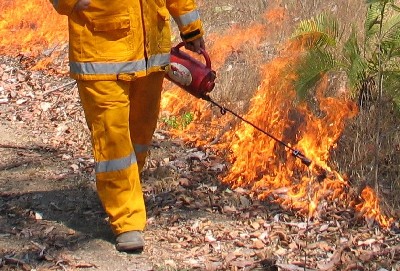 Hazard Reduction: Reducing the World Heritage Hazard
‘Cos see when there’s a real wildfire, Dad’s Army can’t cut the mustard Hazard Reduction: Reducing the World Heritage Hazard
‘Cos see when there’s a real wildfire, Dad’s Army can’t cut the mustard
.
The hazard reduction proceeds on the Sunday 8th September with hardly a breeze in hilly timbered terrain, using trucks only along ‘fire’ trails. We won’t need choppers. They’ll only blow the budget. Sunday night falls, job done and the vols go home. Monday a bit windy, then Tuesday really warm and the wind picks up, gusty to blazes.
The media reports as follows:
<<A hazard-reduction burn that got out of control sparked one of four major bushfires that ravaged western Sydney and the Blue Mountains this week, fire authorities have revealed.
NSW Rural Fire Service Deputy Commissioner Rob Rogers said the National Parks and Wildlife Service had been conducting a hazard-reduction burn near Hawkesbury Road in Winmalee last weekend, which flared up in Tuesday’s soaring temperatures and high winds. [Ed: Winmalee? Close, but try Hawkesbury Heights further north.]
Rob Rogers:
“Basically it was burnt on the weekend, it was patrolled on Monday, there was smouldering activity. That fire then jumped containment lines [on Tuesday].”
.

.
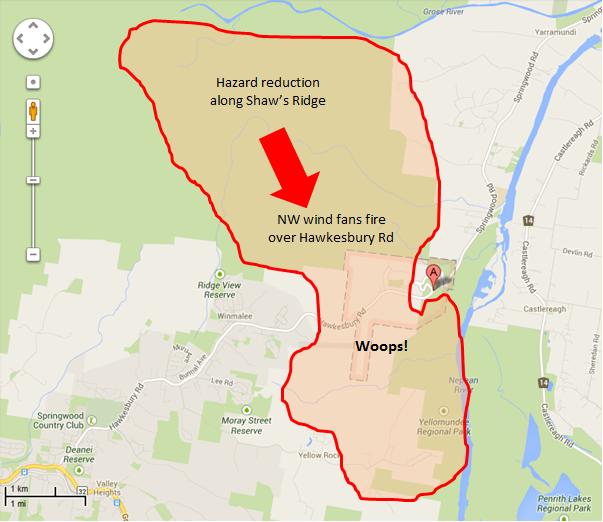 The Parks Service and RFS secretively keep fire operational matters behind closed doors for fear of embarrassment and of being sued.
So our research investigator conducted a post-fire inspection on Saturday 20130921 and has estimated the above impact and scenario.
Perhaps those in charge can prove us wrong? We invited them to.
[Source: The Habitat Advocate, assisted with Google Maps] The Parks Service and RFS secretively keep fire operational matters behind closed doors for fear of embarrassment and of being sued.
So our research investigator conducted a post-fire inspection on Saturday 20130921 and has estimated the above impact and scenario.
Perhaps those in charge can prove us wrong? We invited them to.
[Source: The Habitat Advocate, assisted with Google Maps]
.
<<Just 10 minutes earlier the family had been told by firefighters to remain calm before a freak wind change sent the blaze roaring uphill towards their house. “Evacuate” was the order.>>
[Source: ‘I put my foot down and drove through the fire’: Mother tells how she fled with children in Winmalee’, 20130911, by Taylor Auerbach, The Daily Telegraph, ^http://www.dailytelegraph.com.au/news/nsw/i-put-my-foot-down-and-drove-through-the-fire8217-mother-tells-how-she-fled-with-children-in-winmalee/story-fni0cx12-1226716604185]
.
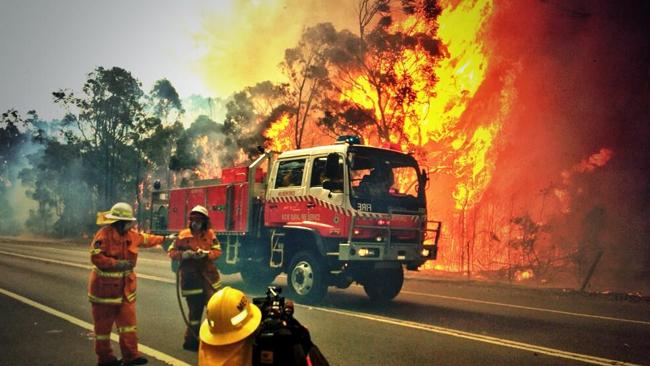 Tackling the Winmalee Hazard Reduction come Wildfire on Hawkesbury Road.
Heroes extinguishing the neglect of their Parks Service cousins. Tackling the Winmalee Hazard Reduction come Wildfire on Hawkesbury Road.
Heroes extinguishing the neglect of their Parks Service cousins.
.
<<A fire burning in the area of Hawkesbury Road at Winmalee has already claimed one property, with more than 100 firefighters working to contain the blaze. Five firefighters have suffered from smoke inhalation and two received minor burns battling the fire in Winmalee.>>
[Source: ‘Bushfire burns Winmalee home, others at risk in Blue Mountains’, 20130910, Sydney Morning Herald, Photo by Nick Moir, ^http://www.smh.com.au/nsw/bushfire-burns-winmalee-home-others-at-risk-in-blue-mountains-20130910-2ths1.html]
.
<< Firefighters have contained a blaze that has burnt through more than 1000 hectares of bushland west of Sydney. The fire, at Winmalee in the Blue Mountains, has been burning since Tuesday fanned by high temperatures and strong winds, plunging the region into emergency. Firefighters were still water bombing the burning bushland on Thursday.
The Rural Fire Service on Friday said the fire had been contained.
RFS spokeswoman Laura Ryan:
“It was brought fully under control last night just before a community meeting at Winmalee High School. Firefighters (unpaid) would today work to extinguish the blaze, but said it was too early to say how long that would take. Firefighters will be working hard to get every bit of that fire out.”
The RFS and NSW Police say they have launched investigations into the cause of the bushfire, with some locals raising concerns that recent hazard reduction burns in the area may be responsible. [Ed: NSW Police need not investigate far beyond the operational records of the Blue Mountains National Parks and Wildlife Service, with internal documents circulated to the RFS]
.
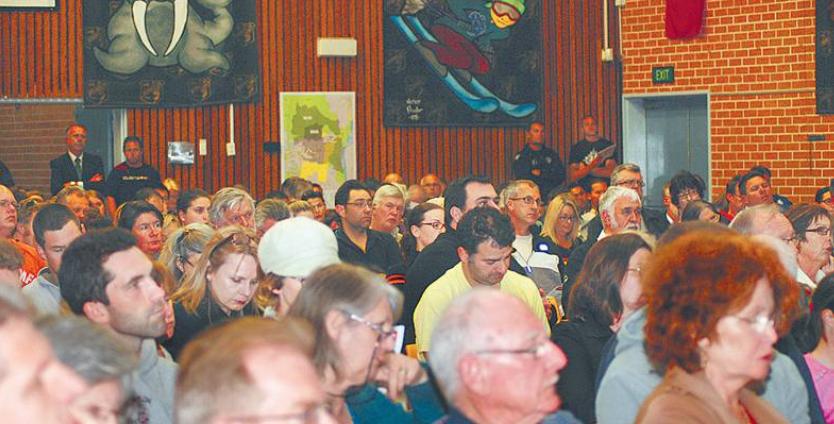 More than 350 Blue Mountains residents pack the Winmalee High School on Thursday night 12th September, fearful whether they could lose their homes to Hazard Reduction.
[Source: ^http://news.ninemsn.com.au/national/2013/09/13/07/00/winmalee-bushfire-contained-rfs]
More than 350 Blue Mountains residents pack the Winmalee High School on Thursday night 12th September, fearful whether they could lose their homes to Hazard Reduction.
[Source: ^http://news.ninemsn.com.au/national/2013/09/13/07/00/winmalee-bushfire-contained-rfs]
.
<< A Rural Fire Service organised community meeting held last week at Winmalee to discuss the fire situation in Winmalee and Yellow Rock was well attended.
Winmalee and Yellow Rock residents aired their bushfire concerns at a community meeting organised by the NSW Rural Fire Service (RFS) at Winmalee High School last Thursday night.
Despite the meeting only being publicised that day, the school hall was nearly full with 350 residents. At least 10 people in the room did not receive an RFS emergency safety warning text message to take shelter.
Blue Mountains RFS district manager David Jones said he would, “feed that back up the line … it may be a service provider issue, I’m not sure, that may be part of it” and that he would look further into the issue.
A Yellow Rock resident asked what hazard reduction burns would take place in Yellow Rock in the near future.
Supt Jones said the weather conditions last week hadn’t been suitable to maintain control of a backburn.
“It’s a one-way, one-road in and its never received the recognition it deserves on that basis in terms of protection,” the Yellow Rock resident said. “I would hate to see a real emergency situation develop here at Yellow Rock.”
Supt Jones said he’d look at the RFS organising a meeting with Yellow Rock residents in the near future to address these issues. Supt Jones said residents could have a fire mitigation officer assess if hazard reduction was needed in their area by lodging a hazard complaint with the RFS.
“Generally over an 8-12 year cycle it [vegetation] needs to be burnt, which allows it to regenerate,” he said.
National Parks and Wildlife Service (NPWS) Upper Mountains area manager Richard Kingswood said there weren’t many days a year suitable for conducting hazard reduction burns — only 10 days in the Upper Mountains and a few more in the Lower Mountains, although last autumn and spring had provided more opportunities. He said in the last financial year NPWS had initiated 38 burning operations over 50,000 hectares, which was more than usually occurred.
Another resident asked why, with safety concerns with overhead powerlines, they couldn’t go underground, especially as the highway was being widened. An Endeavour Energy spokesman said cost was an issue. “It costs about 10 times more to put mains underground.”
Others were concerned about issues around road blocks, where children as well as adults were allowed to walk past roadblocks to return home, yet people couldn’t get their vehicles through. It didn’t make sense from a safety perspective, the resident said.>>
[Source: ‘Concerns aired at Winmalee fire meeting’, 20130918, by Ilsa Cunningham, Blue Mountains Gazette, ^http://www.bluemountainsgazette.com.au/story/1782194/concerns-aired-at-winmalee-fire-meeting/]
.
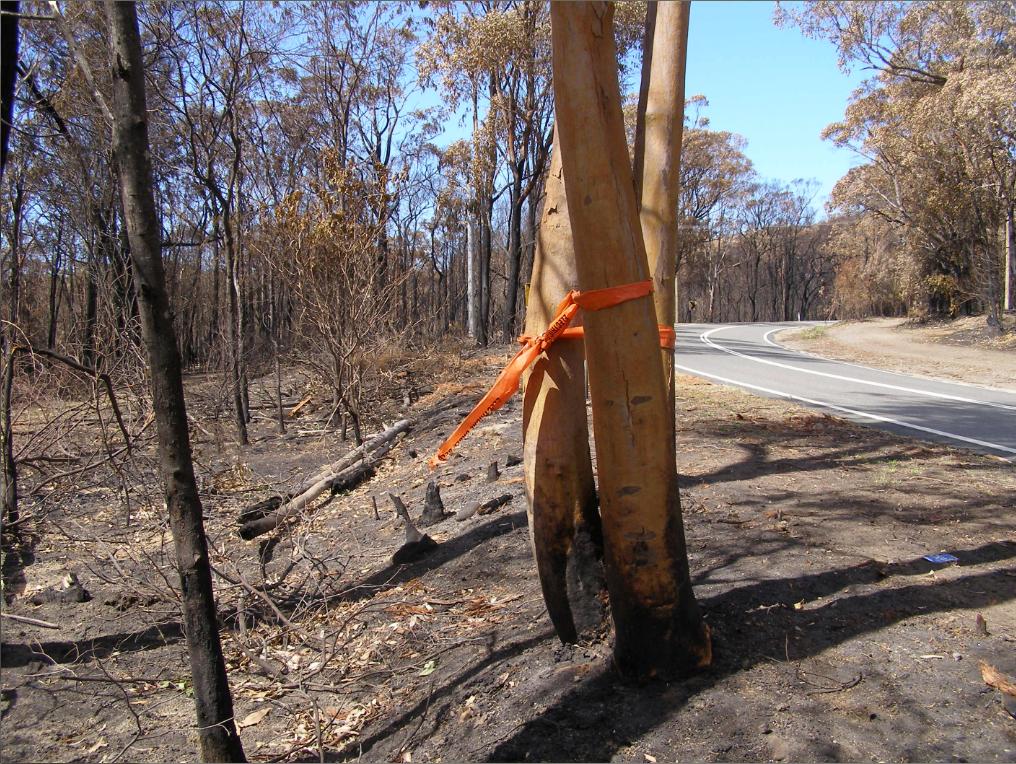 Hawkesbury Road well and truly hazard reduced
[Photo by our Investigator along Hawkesbury Road, Blue Mountains, Australia, 20130921, photo © under ^Creative Commons] Hawkesbury Road well and truly hazard reduced
[Photo by our Investigator along Hawkesbury Road, Blue Mountains, Australia, 20130921, photo © under ^Creative Commons]
.
<< More than 1200 firefighters were involved in battling the four major fires on Tuesday along Hawkesbury Road in Winmalee; in Marsden Park in the Blacktown area; near Tickner Road in Castlereagh; and Richmond Road at Windsor. Fourteen helicopters and 350 trucks from the Rural Fire Service, Fire and Rescue NSW and the National Parks and Wildlife Service were involved in the firefight.
Just before 1.30pm on Tuesday, the temperature in Sydney was 31.6 degrees. Mr Rogers said strong wind also made fire conditions worse, with gusts reaching 90 kilometres an hour, which was much higher than forecast.
He said RFS firefighters helped in the hazard-reduction operation in Winmalee, which was under the supervision of the NPWS, and he apologised to anyone who experienced property damage.
“Combined with the winds, how dry it is, the temperature and the steep terrain, fire takes hold very, very quickly.”
He said the RFS also was investigating whether a hazard-reduction burn escaped and forced the closure of the M1 (formerly the F3) Motorway on Thursday.
“You would have to obviously be suspicious that it did come from a hazard-reduction, given that it was in a very close proximity to it. That’s something that we’re going to be looking at very, very closely,” he said.>>
<<Fire authorities have issued an emergency warning for a bushfire threatening homes in Castlereagh in Sydney’s west, and alerts for other out of control bushfires in Blacktown and Hawkesbury.
NSW Rural Fire Service Deputy Commissioner Rob Rogers said National Parks and Wildlife Service had been conducting a hazard reduction burn near Hawkesbury Road in Winmalee last weekend. The fire flared with Tuesday’s soaring temperatures and high winds.
..He apologised to anyone who experienced property damage from the Winmalee fire. ”..It appears on first look that it’s a case of the weather was worse than was predicted, the fire jumped out, it took hold really..quickly.” >>
Even though the fire ripped through Hawkesbury Heights, the National Parks and Wildlife Services has released a public notice asking any Winmalee residents who experienced property damage or loss have been urged to contact NPWS on 1300 361 967 for sympathy and counselling.
New South Wales Rural Fire Service (paid) Deputy Commissioner Rob Rogers has said that his (unpaid) RFS firefighters helped in the hazard-reduction operation in Winmalee, which was under the supervision of the NPWS, and he apologised to anyone who experienced property damage.
.
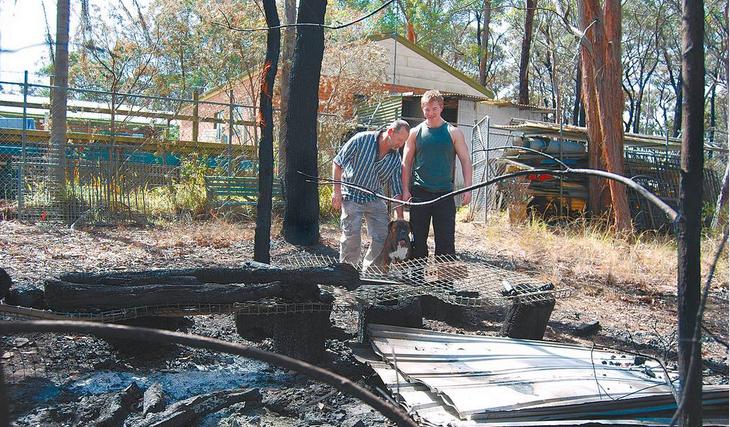 RFS: Sorry about that
Property loss at Hawkesbury Heights (Wheatley Road?) but who pays?
Owner: “we won’t need hazard reduction for a while.”
[Source: ‘Bushfire wake-up call’, 20130918, by Shane Desiatnik,
^http://www.theleader.com.au/story/1782048/bushfire-wake-up-call/] RFS: Sorry about that
Property loss at Hawkesbury Heights (Wheatley Road?) but who pays?
Owner: “we won’t need hazard reduction for a while.”
[Source: ‘Bushfire wake-up call’, 20130918, by Shane Desiatnik,
^http://www.theleader.com.au/story/1782048/bushfire-wake-up-call/]
.
[Sources: ‘Hazard reduction burn started major Sydney bushfire’, by Megan Levy, 20130913, ^http://www.smh.com.au/nsw/hazard-reduction-burn-started-major-sydney-bushfire-20130913-2tois.html; and ‘Burn-offs and arson suspected as cause of two bushfires’, by Megan Levy and Peter Hannam, 20130914, ^http://www.smh.com.au/nsw/burnoffs-and-arson-suspected-as-cause-of-two-bushfires-20130913-2tq15.html]
.
National Parks and Wildlife Advisory Council Report
(42nd meeting held on 28-29 May 2013)
.
<< Council noted the following details regarding the current status of fire management activity by NPWS:
- The 135 000ha annual target has been met with a total of 176 000ha now treated.
- Almost 3 times more area treated than the average for last five years.
- 6-7000ha hazard reduction activity planned over the next week.
- Opportunity to increase positive community profile for NPWS.
- Statewide strategy with performance indicators in place at state and regional levels. >>
.
[Source: New South Wales Government, NSW National Parks and Wildlife Service, ^http://www.environment.nsw.gov.au/resources/about/NPWAdvisoryCouncMay2013.pdf]
.
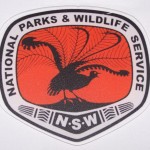 In Parks we Trust In Parks we Trust
.
In New South Wales the National Parks and Wildlife Act became law on 1 October 1967. The legislation created a single agency, the National Parks and Wildlife Service, to care for, control and manage the original nineteen parks and any new ones created in the future.
.
.
.
Further Reading:
.
[1] ‘NPWS Fire Fighters Recognised for Service as NSW Gets 10 Year Fire Plan‘, 20130422, NSW Government, ^http://www.environment.nsw.gov.au/resources/MinMedia/MinMedia13042201.pdf
.
[2] ‘National Parks and Wildlife Advisory Council Report‘, 42nd meeting held 20130528-29, NSW Government, ^http://www.environment.nsw.gov.au/resources/about/NPWAdvisoryCouncMay2013.pdf
.
[3] ‘Fire Management Manual, 2012-2013‘, NSW National Parks and Wildlife Service, NSW Government, ^http://www.environment.nsw.gov.au/resources/firemanagement/final/OEH20120645FireMgmtManual.pdf
.
[4] ‘Blue Mountains National Park Plan of Management‘, May 2001, NSW National Parks and Wildlife Service, ^http://www.environment.nsw.gov.au/resources/parks/pomfinalbluemountains.pdf
.
[5] ‘Greater Blue Mountains World Heritage Area – Strategic Plan‘, January 2009, Department of Environment and Climate Change (NSW) with funds supplied by the Australian Government, ^http://www.environment.nsw.gov.au/resources/parks/StategicPlanNPWS.pdf
.
[6] ‘National parks and forest conservation‘, 2006, by Brett J. Stubbs, School of Environmental Science and Management, Southern Cross University, Lismore, New South Wales ^http://fennerschool-associated.anu.edu.au/environhist/links/publications/anzfh/anzfh1stubbs.pdf
.
Tags: Blue Mountains, bush arson, Greater Blue Mountains World Heritage Area, Hawkesbury Heights, Hawkesbury Road, Hawkesbury Road Winmalee Fire, hazard reduction, hazard reduction out of control, National Parks and Wildlife Service, NSW Rural Fire Service, Shaws Ridge, Winmalee Hazard Reduction, Yellow Rock
Posted in Blue Mountains (AU), Threats from Bushfire | 2 Comments »
Add this post to Del.icio.us - Digg
Thursday, September 26th, 2013
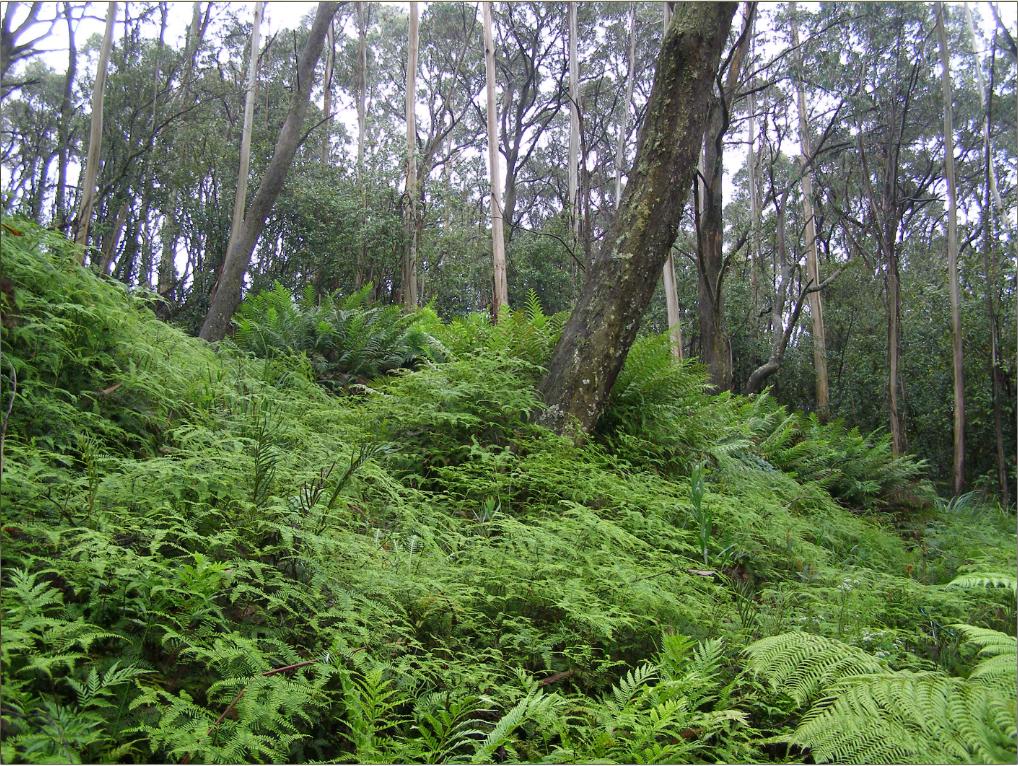 This is a Blue Mountains Swamp
It is a surviving remnant of Blue Mountains Swamps in the Sydney Basin Bioregion ecological community, which in 2005 were listed as Endangered by the Commonweath Threatened Species Scientific Committee.
[Photo by Editor 20120128, photo © under ^Creative Commons]
Click image to enlarge This is a Blue Mountains Swamp
It is a surviving remnant of Blue Mountains Swamps in the Sydney Basin Bioregion ecological community, which in 2005 were listed as Endangered by the Commonweath Threatened Species Scientific Committee.
[Photo by Editor 20120128, photo © under ^Creative Commons]
Click image to enlarge
.
Blue Mountains Swamps?
.
Blue Mountains Swamps are globally restricted to the Central (and upper) Blue Mountains and to Newnes Plateau at altitudes between 600 m to 1200 m AMSL. They exist on peat soils above a sandstone substrate geomorphology. The soil tends to be water logged due to the presence of constant groundwater seeping over the impermeable claystone layers in the sandstone which impedes their drainage, however some swamps can be constantly flooded or else ephemeral, varying with seasonal rainfall patterns and more long term with El Niño/La Niña climatic phases.
Blue Mountains Swamps are typically situated at the headwaters of watercourses below ridges, but can also be hanging swamps on steep ridges, or valley bottom swamps. The structure and species composition of Blue Mountains Swamps varies with localised geology, topographic location, depth of the water table, extent and duration of water logging, drainage gradients, sedimentation and soil type.
Blue Mountains Swamp vegetation structure can range from being open or closed variants of sedgeland, rushland, heath, tussock grassland, tussock grassland, tall grassland, scrub and tall shrubland. The vegetation is typically under 3 metres in height, although taller shrubs may be present. Emergent tree species favouring wet root systems can occur on the swamp margins, and the vegetation here tends to be closed woodland in their undisturbed natural state.
Both the structure and species composition of swamp vegetation vary from site to site, and the individual species and structural types shown below do not all occur at every site. Within a single swamp area a complex mosaic of vegetation types (structure and species composition) may be present.
The structure of Temperate Highland Peat Swamps on Sandstone vegetation includes sedgeland, closed sedgeland, open-rushland, open-heath, closed-heath, tussock grassland, closed-tussock grassland, tall closed-grassland, open-scrub and tall shrubland. The vegetation is usually less than 3 m in height, although taller shrubs may be present. Emergent trees may occur on swamp margins, and the vegetation here tends to open woodland.
Typical vegetation is characterised by the presence of sedges, graminoids (grass-like plants) and forbs (herbaceous non-grass or grass-like plants) with or without shrubs. They are endemic to the upper Blue Mountains, comprising numerous small patches which aggregate to being about 3,000 heactares in total area. They occur naturally nowhere else on the planet.
Blue Mountains Swamps are scientifically included as a class within the nationally recognised Temperate Highland Peat Swamps on Sandstone ecological community. On 29th April 2005, Temperate Highland Peat Swamps on Sandstone was included in the list of nationally threatened ecological communities under section 181 of Australia’s Environment Protection and Biodiversity Conservation Act 1999. [Source: ^http://www.comlaw.gov.au/Details/F2005L01134]. This was mainly due to Threatened Species Scientific Committee recognising its limited distribution and vulnerability to ongoing threats.
It followed a ten year campaign by Blue Mountains environmentalists..
.
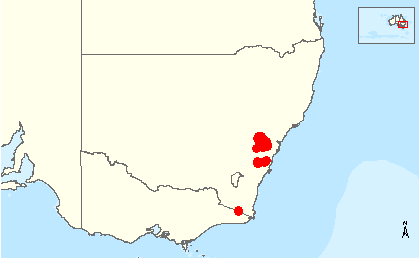 Global distribution map of Temperate Highland Peat Swamps on Sandstone ecological community.
[Source: Temperate Highland Peat Swamps on Sandstone, Biodiversity, Species Profile and Threats Database, Department of the Environment, Australian Government, ^http://www.environment.gov.au/cgi-bin/sprat/public/publicshowcommunity.pl?id=32#status] Global distribution map of Temperate Highland Peat Swamps on Sandstone ecological community.
[Source: Temperate Highland Peat Swamps on Sandstone, Biodiversity, Species Profile and Threats Database, Department of the Environment, Australian Government, ^http://www.environment.gov.au/cgi-bin/sprat/public/publicshowcommunity.pl?id=32#status]
.
Twynam Swamp
.
Twynam Swamp is essentially an upland Blue Mountains Sedge Swamp dominated by coral fern (Gleichenia dicarpa).
It is situated on a hillside at the headwaters of Katoomba Creek in the heart of the distribution area for Temperate Highland Peat Swamps on Sandstone. The swamp here is predominantly a sedge swamp and is permanently water logged, probably due to the localised presence of natural groundwater springs.
This particular upland swamp area features a diverse ecological community including the following indicator swamp flora species:
.
-
Coral Fern (Gleichenia dicarpa),
-
King Fern (Todea barbara)
-
Tasman Flax-lily (Dianella tasmanica)
-
Soft Twig Rush (Baumea rubiginosa)
-
Fork-leaved sundew (Drosera binata)
-
Red-fruit Saw Sedge (Gahnia sieberiana)
-
Alpine Heath (Epacris paludosa)
-
Spreading Rope Rush (Empodisma minus)
-
Mat Rush (Lomandra longifolia)
-
Peat Moss (Sphagnum cristatum) in the ground layer
.
and a range of Hakea and Grevillea shrub species.
.
Characteristic of this upper Blue Mountains ridgeline landscape, above this swamp margin stands emerging Eucalyptus oreades, endemically rare in their own right.
Twynam Swamp is but one of the Blue Mountains Swamps localised fragile ecosystems coming under increased pressure mainly by deforestation for housing development and by frequent bushfires especailly from broadscale hazard reduction regimes. Both practices are not only facilitated by government, but sanctioned and enshrined in legislation, despite being scientifically recognised as key threatened processes.
.
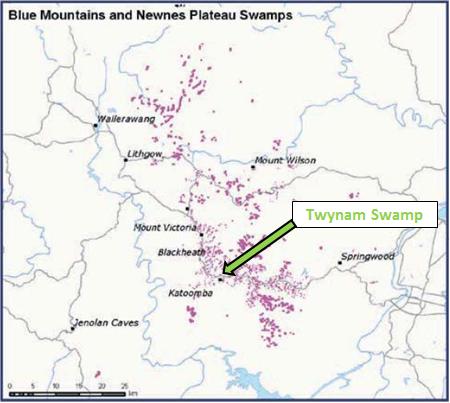 Larger scale distribution map of Blue Mountains and Newnes Plateau Swamps
[Source: ‘Nationally threatened species and ecological communities’, Department of the Environment, Australian Government,
^http://www.environment.gov.au/biodiversity/threatened/publications/pubs/temperate-highland-peat-swamps.pdf] Larger scale distribution map of Blue Mountains and Newnes Plateau Swamps
[Source: ‘Nationally threatened species and ecological communities’, Department of the Environment, Australian Government,
^http://www.environment.gov.au/biodiversity/threatened/publications/pubs/temperate-highland-peat-swamps.pdf]
.
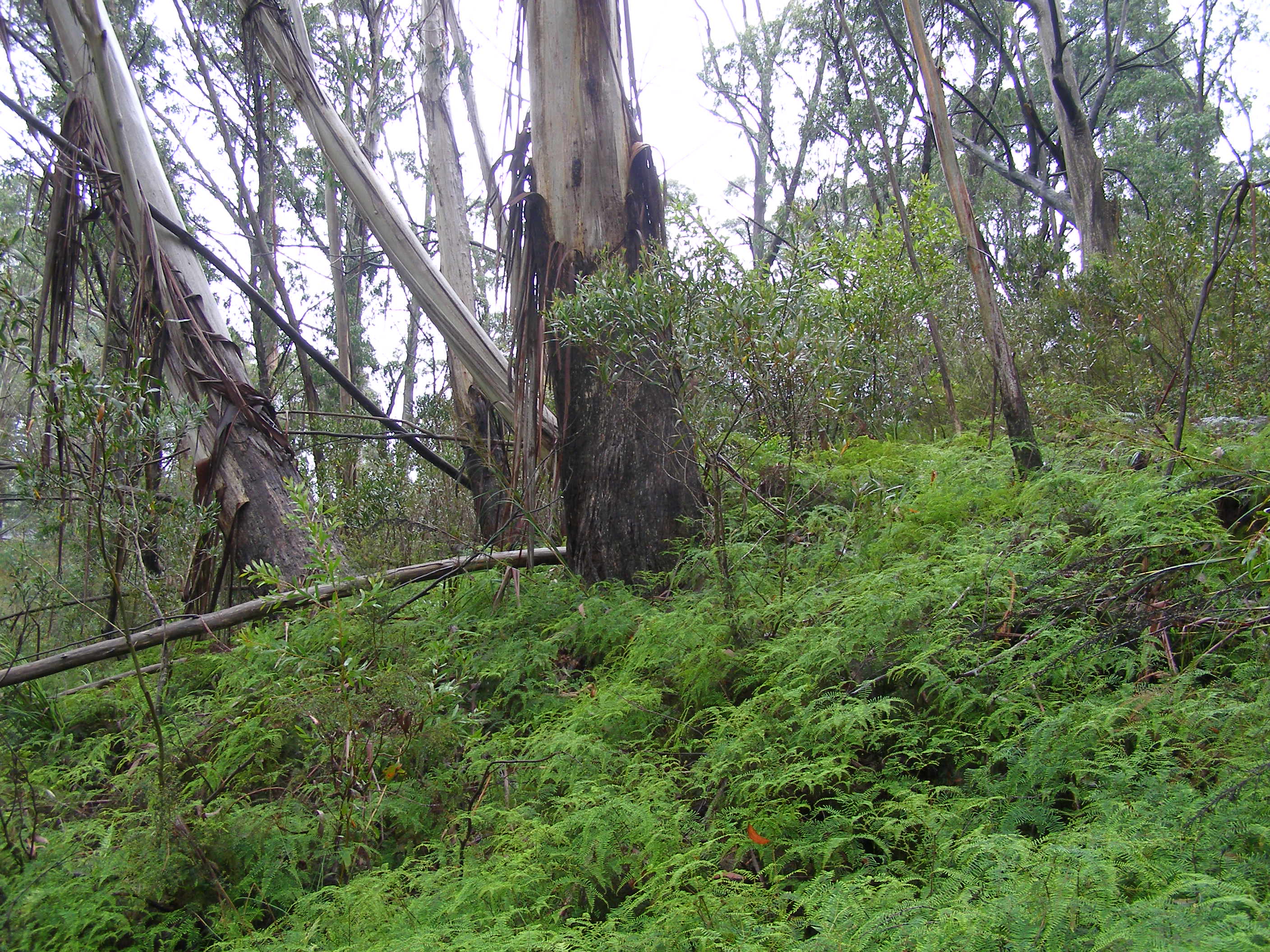 This Blue Mountains Swamp also contains a rare significant stand of Eucalyptus oreades (Blue Mountains Ash) around its periphery, which in itself holds rare ecological value.
[Photo by Editor 20120128, photo © under ^Creative Commons]
Click image to enlarge This Blue Mountains Swamp also contains a rare significant stand of Eucalyptus oreades (Blue Mountains Ash) around its periphery, which in itself holds rare ecological value.
[Photo by Editor 20120128, photo © under ^Creative Commons]
Click image to enlarge
.
But try telling this to the local Blue Mountains Council. Council has just approved the bulldozing through and above this endangered and protected swamp for housing development.
Council’s zoning under its own Local Environment Plan of 1991 actually recognises this particular swamp as being environmentally protected. The swamp covers much of the Katoomba Creek headwaters site that has just been approved for housing development at the end of Twynam Street. It practically adjoins a restricted Sydney Water Catchment area on the ridgetop.
This site is a swamp. It has no connected water, power, gas or telephone. It has no stormwater connection. It is a swamp.
Not surprisingly, the developer’s Flora and Fauna Assessment has concluded that the bulldozing of the swamp will “unlikely.. (cause) any significant impact on any endangered ecological community, population or any threatened species and as such a Species Impact Statement.” [Source: Anderson Environmental Consultants, May 2012, for 121 Twynam Street, p. 13]
So Blue Mountains Council’s Senior Environmental Health and Building Surveyor, Daniel Roberts, approved construction two weeks ago (12th September 2013) for a two storey dwelling and driveway to carve through this Blue Mountains Swamp. The consent conditions for this development application (X/673/2012) read as if the site was just an urban block of land in downtown Sydney; nothing special.
Rules for some?
Still council’s wholesome vision advocates “respecting our heritage and safeguarding our fragile environment” – a clear disconnect between propaganda and practice.
.
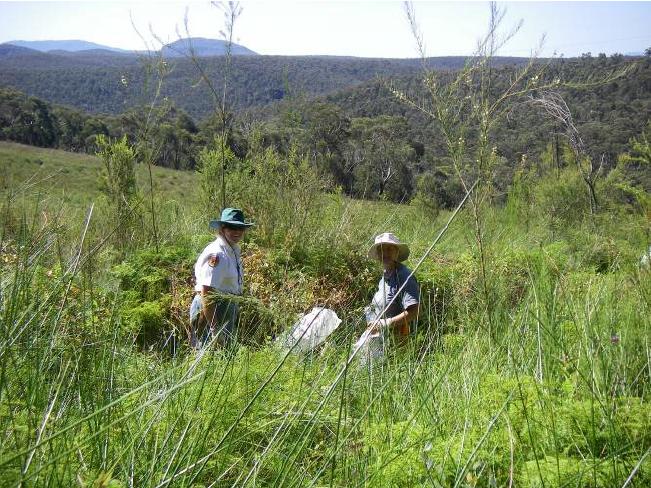 Blue Mountains Swampcare at Kittyhawke Swamp, Wentworth Falls.
Similar swamp characteristics, just more convenient location for Council and Parks Service to jointly show they care.
[Source: Blue Mountains Council’s Upland Swamp Rehabilitation Programme (2007) enticing community volunteers.] Blue Mountains Swampcare at Kittyhawke Swamp, Wentworth Falls.
Similar swamp characteristics, just more convenient location for Council and Parks Service to jointly show they care.
[Source: Blue Mountains Council’s Upland Swamp Rehabilitation Programme (2007) enticing community volunteers.]
.
Ed: To Blue Mountains Council development staff, ‘Temperate Highland Peat Swamps on Sandstone’ national legislation is a discretionary matter depending upon where the swamp happens to be situated.
.
Blue Mountains Council is content to be hypocritical about its stance on protecting Blue Mountains Swamps under its Swampcare Programme, while at the same time its development planning staff authorise destruction of these swamps. It is in flagrant breach of national legislation.
Fortunately, there remain many in the local Blue Mountains community who place high value and have due respect for Blue Mountains Swamps and their need for consistent protection under the national legislation, irrespective of where the swamps happen to be situated. Next door resident, Francis Scarano, has repeatedly objected to the Blue Mountains Council about this development’s certain destructive impact upon the swamp:
.
“The swamp out the front will die along with the E. Oreades as they are not able to cope with excavation for the drive way across roots and concrete next to them and the swamp cannot cope with cut ground water supplies.
What happens when you build above a swamp? You kill a swamp even if you do not build on it. Development above is more than enough to do the job. Winding roads around Eucalyptus oreades grove and building turning bays is enough to make the trees in groves to fall down. Even though the developer is not clearing the oreades grove or swamp his actions will kill them all the same but more slowly.
The swamp particularily depends on the hydrology ie underground springs being undisturbed. They do not understand that building above a swamp will kill it anyway.”
.
Her concerns have fallen on deaf, ignorant ears at Blue Mountains Council.
But council ignorance has not stopped local residents making a stand to save this precious remnant swamp.
.
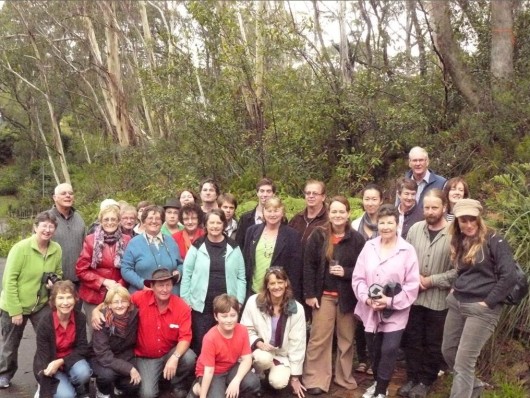 Friends of Twynam Swamp
A collective of friends of Francis Scarano who stand in solidarity with Frances Scarano
to save Twynam Swamp (behind) from the developer’s bulldozer.
[© Photo by Francis Scarano, 20130327] Friends of Twynam Swamp
A collective of friends of Francis Scarano who stand in solidarity with Frances Scarano
to save Twynam Swamp (behind) from the developer’s bulldozer.
[© Photo by Francis Scarano, 20130327]
.
Tags: Alpine Heath, Baumea rubiginosa, Blue Mountains Swampcare, Blue Mountains Swamps, Coral Fern, Dianella tasmanica, Drosera binata, Empodisma minus, Epacris paludosa, Fork-leaved sundew, Gahnia sieberiana, Gleichenia dicarpa, indicator swamp flora species, King Fern, Lomandra longifolia, Mat Rush, Peat Moss, Red-fruit Saw Sedge, Soft Twig Rush, Sphagnum cristatum, Spreading Rope Rush, Tasman Flax-lily, Temperate Highland Peat Swamps on Sandstone, Todea barbara, Twynam Swamp
Posted in Blue Mountains (AU), Threats from Development, Threats from Greenwashing, Threats from Weak Environmental Laws | No Comments »
Add this post to Del.icio.us - Digg
Monday, September 23rd, 2013
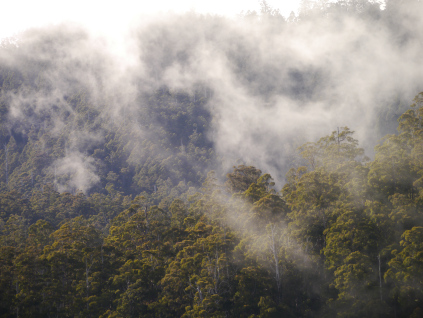 In Tasmania, pristine remains defenceless
In Tasmania, pristine remains defenceless
.
Hope from 2013:
.
“Today I think of the Wedge-tailed Eagle that I watched fly above my tree, whose habitat was once under threat and is now protected and of the Tasmanian Devils who lived in the forest 60 metres below my platform who can now raise their young in peace.”
.
~ Miranda Gibson, The Observer Tree, Tasmania, ‘National student movement stands up for Tasmania’s native forests’, 20130710,
^http://observertree.org/2013/07/10/media-release-national-student-movement-stands-up-for-tasmanias-native-forests/]
.
Recalling the STIHL nightmare from 1982:
.
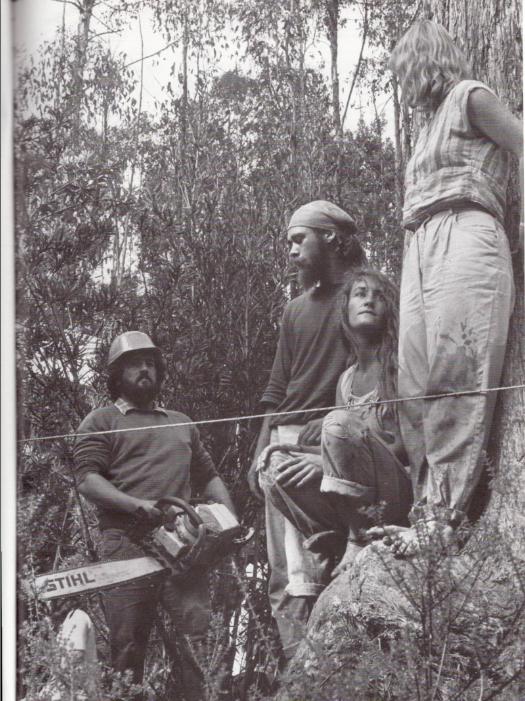 Tasmania’s Farmhouse Creek Conservation Blockade of 1982: the people’s forest stance against industrial ecocide. Moral courage in the face of adversity – it resonates with the robust spirit of our brave young people. Lest we forget our young folk’s personal exposure to Corporate Logger Bully Violence, personal sacrifice and its haunting trauma. Tasmania’s Farmhouse Creek Conservation Blockade of 1982: the people’s forest stance against industrial ecocide. Moral courage in the face of adversity – it resonates with the robust spirit of our brave young people. Lest we forget our young folk’s personal exposure to Corporate Logger Bully Violence, personal sacrifice and its haunting trauma.
[Source: ‘For the Forests – A history of the Tasmanian Forests Campaigns’, 2001, book by Helen Gee and Janet Fenton, The Wilderness Society, Hobart, Tasmania]
.
From 2001:
.
<< In a world in which the tropical forests are disappearing and oldgrowth forests are threatened everywhere, global biodiversity is declining at an alarming rate. Australia can no longer afford to destroy oldgrowth forests. They are a priceless resource. Few of our tall forests of any type remain in pristine condition,and particularly where they have not been degraded they should be protected. The practice of destroying oldgrowth forests in order to replace it with plantations is criminal vandalism. Plantations should only be established on already degraded land.
Tasmania has the tallest forests in the Southern Hemisphere, some of the greatest areas of pristine temporate Gondwanan rainforest found anywhere on Earth, and some of the world’s oldest trees. This makes it a Mecca for tourists as forests disappear elsewhere. Because Tasmania is the State with the most forest – 40% of area forested – and because the quite erroneous view prevails that forests regenerate completely after clearfelling, a shameful attitude to forest conservation exists at the highest level in bureaucracies.
The Island is being torn apart by the woodchip-at-any-cost mentality. The forests are being sold off at a loss. The royalties paid by private companies fall far short of covering the cost of forest management, regrowth and infrastructure. Job losses attributable to woodchipping were estimated at 4,000 by 1995 – refuting the contention that the industry is good for employment. The Government, for sake of keeping a few foresters in work for a few years does not have the fortitude to stop the destruction. >>
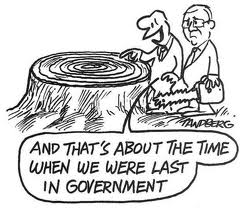
<< Gondwanan forest, in its complex rainforest and wet scherophyll expression, does not regenerate to form its original mixture. The complex web of life that it comprises, the extraordinary antiquity and grandeur of its thousands-of-years-old giant components, and the untold interactions betwen its macroscopic and microscopic plant and animal species and soil biota, make it a living entity – ‘a surviving dinosaur deserving of complete protection’.
Over 70% of forests logged are clearfelled in Tasmania, destroying habitats and most of the wildlife they support. Replacement plantations and regenerated areas cannot provide the range of habitats or the biota. Over 90% of the timber extracted from natural forests is woodchipped and only five percent ends up as sawn timber. (An estimated five million cuibic metres of woodchips a year are sold, mainly to Japan). The common practice of burning ‘waste’ in felled coupes, a scorched earth policy, results in total slaughter of small animals and organisms, many of which are little known or understood. >>
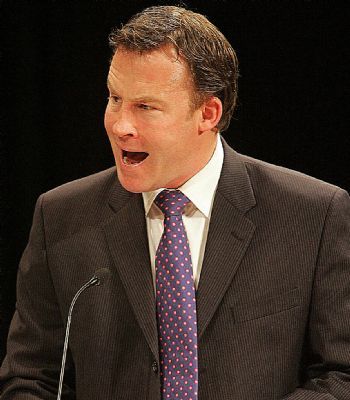 Dark Forces Regrouping
Will Hodgman’s 20th Century ignorant wrath
..against everything naturally Tasmanian Dark Forces Regrouping
Will Hodgman’s 20th Century ignorant wrath
..against everything naturally Tasmanian
.
<< Even at the start of a new millenium, logging operations are penetrating into more of the untouched valleys. Forests of World Heritage value are being destroyed and the integrity of the World Heritage protected areas themselves is being compromised. The damaging effect of logging operations, and particularly the clearfelling, on streams and on the hydrology of catchments, and on soils, is never taken into account and is a serious consequence. The brave people who have spoken out, risked their lives and faced arrest at peaceful direct actions around the Island, need your support. Every Australian who appreciates the heritage values of our forests and wants future generations to experience them, can learn what is at stake here and support the campaigns that are ongoing. >>

~ Mary E White DSc
[Source: Forward by Mary E White in book by Helen Gee (b.1950) and Janet Fenton: ‘For the Forests – A history of the Tasmanian Forests Campaigns’, 2001, published by The Wilderness Society, Hobart, Tasmania]
.
.
Further Reading:
.
[1] Helen Gee’s 2001 book ‘For the Forests: A History of the Tasmanian Forest Campaigns‘, (with Janet Fenton) published by The Wilderness Society, Inc. [^Read More]

.
‘Oral history of the Tasmanian forest campaigns. Compilation of over 100 interviews of artists and activists, politicians and environmentalists such as Senator Bob Brown and Alec Marr, Campaign Director of the Wilderness Society. Chronicles strategies, protest marches, and achievements of campaigns. Foreword by palaeobotanist Mary E White. Copiously illustrated, includes appendices, maps, chronology, bibliography and index. Author is a Tasmanian writer and environmentalist, writer of ‘The South West Book: A Tasmanian Wilderness’.’
.
[2] Extracts of an interview Dr Mary White in 2003 by Amy Heague (Focus Magazine), ^http://focusmag.com.au/mgl/interviews/dr-mary-white-paleobotanist
.
<< When Dr Mary White moved to the Manning Valley (New South Wales mid-north coast) back in 2003, the area acquired a true visionary and pioneer in the world of Paleobotany and environmental conservation.
Dr White has an amazing career that spans over five decades and two southern continents, is an accomplished and award winning palaeobotanist, lecturer and over the last 20 years author of several award winning books on the evolution of the Australian continent and its ecosystems. She is a passionate conservationist, was named a Member (AM) in the General Division of the Order of Australia for service to botany as a researcher through promotion of increased understanding and awareness of the natural world and just a few weeks ago was awarded the Lifetime Conservation Award from Australian Geographic.>>
.
Interviewer: You came to Australia in 1955. Tell us about your first encounter with Australian plant life.
Dr White: We docked at Fremantle and had three days to wait until we came to Sydney, so we hired a car and went to look at the sand plains and wildflowers. I was amazed at how the composition of the flora was just slightly different from what I had been finding in South Africa.
I had this questioning feeling; how had I travelled thousands of miles across the ocean to get here and yet I could recognise at a family level everything growing around me. It was the same kind of ecosystem I had just come from. So, I suddenly was confronted with the concept of Gondwana and believed it totally.
.
Interviewer: What prompted you to purchase Falls Retreat at Johns River at the base of Middle Brother in 2003?
Dr White: I wanted somewhere I could covenant the land to maintain biodiversity and develop as an environmental education centre. It is in a wonderful part of the world and well worth protecting. Since we’ve done all the plant, animal, bird, bat and frog lists and what not, we have realised that the biodiversity here is much, much richer than we ever thought it was going to be. We have even found a couple of rare and endangered frogs.
I am now very much into climate change and have a very important message to send, which is hopefully what I have been concentrating on doing and intend to do for the rest of my life. I decided a long time ago I was going to die at a 107, so I have a few good years left in me yet – so be warned! >>
.
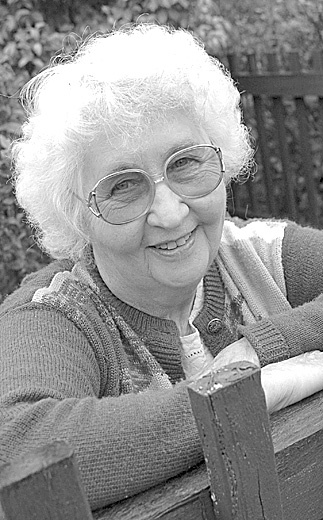 Dr Mary White – Paleobotanist, curator, author
(b.1926 in then Southern Rhodesia) Dr Mary White – Paleobotanist, curator, author
(b.1926 in then Southern Rhodesia)
.
<<..original ecosystems must be preserved because they are complete and have all the interconnections. “Ultimately you need to understand that this is a living planet and it behaves like a huge super organism, and that everything is interconnected and interrelated.”>>
[Source: ‘Dr Mary White Moves On’, 20130806, ABC NSW Mid North Coast, by Carla Mascarenhas, ^http://www.abc.net.au/local/stories/2013/08/06/3819380.htm]
.
Saturday, September 21st, 2013
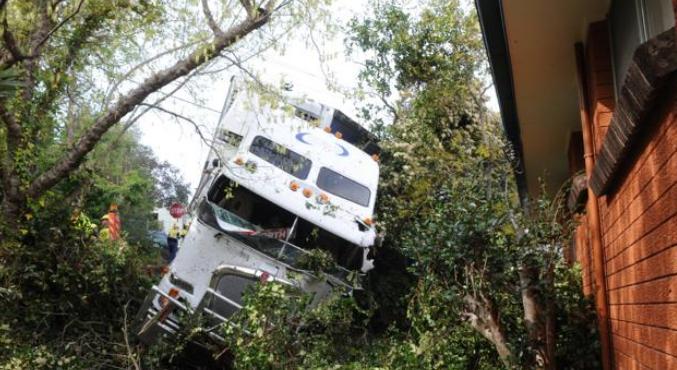 Riverside Refridgerated Transport semi-trailer loses control at speed at night in the wet on the Great Western Highway in an 80kph zone
Then crashes into a Springwood home narrowly missing the occupants.
Last Monday 20130916 near midnight Riverside Refridgerated Transport semi-trailer loses control at speed at night in the wet on the Great Western Highway in an 80kph zone
Then crashes into a Springwood home narrowly missing the occupants.
Last Monday 20130916 near midnight
.
This loaded semi-trailer was being driven by 43 year old truck driver from Cowra, where Riverside Refridgerated Transport is based. It was near midnight and he was likely delivering refridgerated farm produce to Sydney markets.
Problem is that it was wet and along that section of the Great Western Highway through Springwood the speed limit is 80kph. So the truck driver must have been either speeding or fell asleep at the wheel, or both. The semi careered off the highway on the right bend and ploughed into a telegraph pole, cutting it in half under the force, then crashed into the side yard of 2 Boland Avenue, just metres from the house and its innocent occupants.
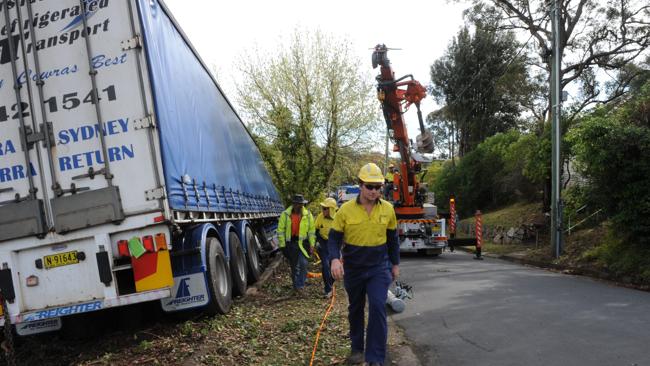 So much for carting Cowra’s best produce to market
Pay peanuts, cut corners… So much for carting Cowra’s best produce to market
Pay peanuts, cut corners…
.
The crash also ruptured a gas main, which caused a significant leak, causing all west bound lanes of the highway to be closed for one and a half hours. Police also had to evacuate residents from another two nearby homes.
[Source: ‘Driver, family escape close call’, 20130917, Cowra Guardian newspaper, ^http://www.cowraguardian.com.au/story/1781566/driver-family-escape-close-call/]
.
What caused the crash? The media is quick to report the crash as a newsworthy story, but rarely investigates the cause nor takes much interest in the repeated recurrence on our highways.
The government authority responsible for trucking operations and for road design and safety across New South Wales is the Roads and Maritime Services (the old RTA-com-RMS, just rebranded). There is no crash barrier on this right bend of the Great Western Highway, yet this particular road section allows for all vehicles to travel at 80 kph. It is just past a down hill run, so how many vehicles travelling east typically nudge 90 kph, including trucks?
The RTA-come-RMS doesn’t care. Has it ever had speed monitoring at this location? Road policy at the RTA-come-RMS is that crash barriers and upgrades to highway safety are not implemented unless there is a history of “crash data”. Someone has to die before the RTA-come-RMS does anything.
Consider the nearby George Street intersection with the Great Western Highway just a kilometre east. When the highway was widened gto four lanes and tranformed into a 80 kph trucking expressway, George Street access was without traffic lights. Entry into the highway was Russian Roulette. Around this four laned expressway section of the Great Western Highway between 2000 and 2010, as it travels through Springwood, some 137 crashes have been documented according to Blue Mountains Council records. [Source: ‘Springwood to Valley Heights Link Road -Traffic Modelling Report, 20120408, by GST Consultants p.5, – see report attached at end of this article].
Wider and faster is not safer! More faster bigger trucks are not safer!
Midnight trucking is inherently deadly because late and night and the early hours of the morning only defies the human biological clock when humans naturally need sleep. Graveyard shift work on the road through the night is killing truck drivers and fellow motorists sharing the highway. Midnight trucking is a ticking time bomb.
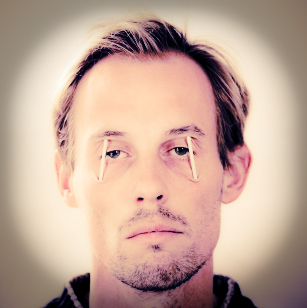 Fatigue Management is a farce
Fatigue Management is a farce
…just don’t forget to spell towns properly in your log book.
.
Yet governments across Australia including the New South Wales government are encouraging this unnatural practice, by accommodating the trucking industry with bigger roads and transforming regional highways like the Great Western Highway into national trucking expressways.
And as they build bigger roads for bigger trucks, they destroy the environment and roadside communities.
 Bullaburra disappearing
Photo by Editor in Blue Mountains, Australia, 20130630, photo © under ^Creative Commons]
Click image to enlarge Bullaburra disappearing
Photo by Editor in Blue Mountains, Australia, 20130630, photo © under ^Creative Commons]
Click image to enlarge
.
Australian governments at national and state levels are changing laws to allow for larger and longer trucks B-doubles and B-triples to do the overnight linehaul task best suited to trains.
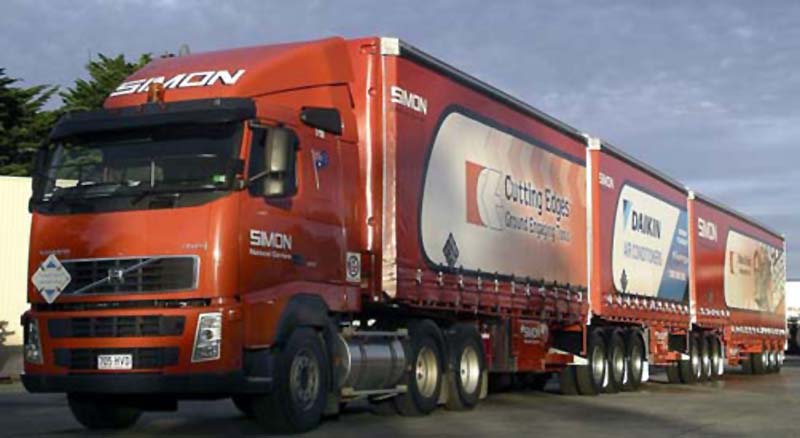 B-triples (basically ‘road-trains’) have already been introduced on regional highways in South Australian, Queensland and Victoria B-triples (basically ‘road-trains’) have already been introduced on regional highways in South Australian, Queensland and Victoria
.
Yet despite national legislation to try to address the systemic fatigue problem amongst linehaul truck drivers, goivernment agencies like the RTA-come-RMS provbide not fatigue managemnent infratructure along the entire length of the Great Western Higwhay between Penrith and Orange.
It’s a disgraceful “she’ll be right” mindset – just use the servos or park your rig on the highway shoulder outside local residents homes, like opposite the Caltex servo in Mount Victiria and leave your refrigerator compressor on all night.
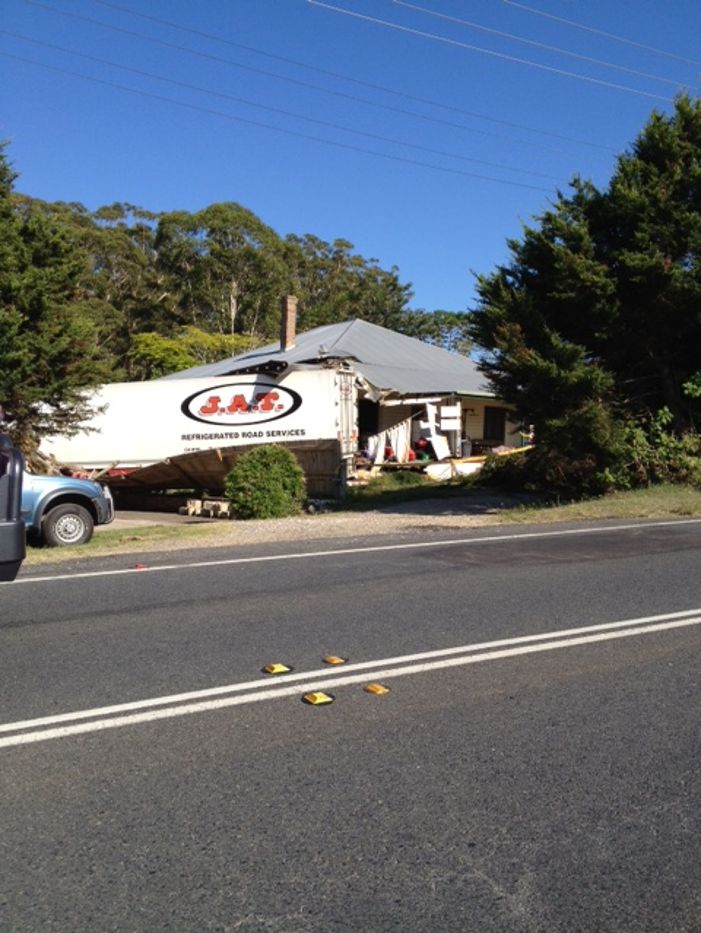 Midnight Refridgeration
…passing through a town near you Midnight Refridgeration
…passing through a town near you
.
Five days previously in Adelaide, on Wednesday 20130911, at about 1:00 am a B-Double left Glen Osmond Drive in the suburb of Frewville and collected a parked van, stobie pole, water hydrant and gas meter, before coming to a rest in the front of the Singapore House restaurant at 203 Glen Osmond Road.
[Source: ‘B-Double truck crash ends in restaurant’, 20130911, by Brett Williamson, ABC, ^http://www.abc.net.au/local/stories/2013/09/11/3846020.htm].
.
Last week, a speeding truck careered down a hill and overturned into a house at Cottage Point in northern Sydney.
[Source”: ‘Truck crashes into cars, boats and house’, 20130904, Yahoo!7, ^http://au.news.yahoo.com/video/national/watch/18778570/truck-crashes-into-cars-boats-and-house/]
.
In February this year, a B-double ploughed into a residential house in Sydney.
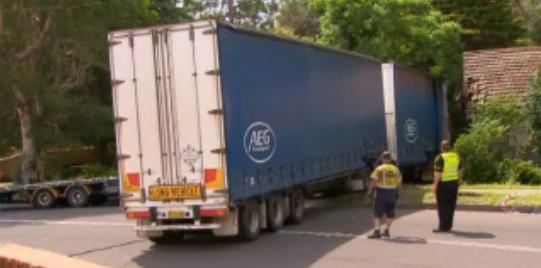
[Source: 9RAW, 20130226, ^http://video.au.msn.com/watch/video/9raw-truck-crashes-into-sydney-home/x6ztgyn?cpkey=8b31708a-606a-4ae7-b648-e55d939f0796%257c%257c%257c%257c]
.
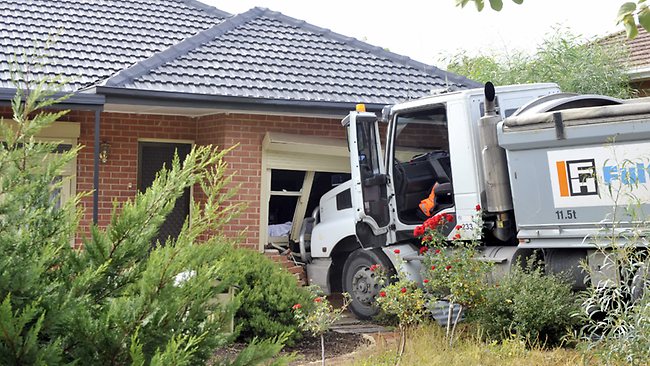 Sand Truck smashes into Adelaide house 2011 Sand Truck smashes into Adelaide house 2011
.
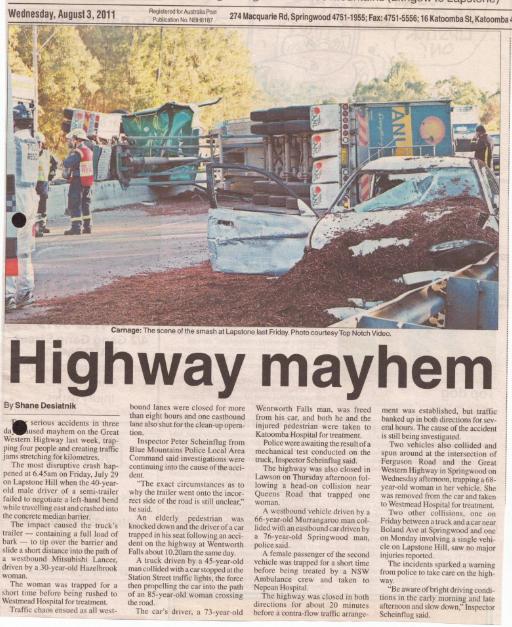 Not the first time for midnight trucking on four laned sections of the Great Western Highway
..and this is before you get to the deadly six-laned M4. Not the first time for midnight trucking on four laned sections of the Great Western Highway
..and this is before you get to the deadly six-laned M4.
.
Still, the NSW Government remains manifestly committed to its 20th Century trucking mindset, ignoring big picture freight rail. It has this week just announced it will spend $11.5 billion on a 33 km trucking motorway across Sydney. That is nearly a third of the annual Gross Domestic Product of New South Wales.
Just as the F3 was widened from two lanes each way, the existing M4 is to be widened to four lanes each way.
[Source: ‘Green light given for the 115 billion west connex motorway’, 20130919, by Andrew Clennell State Political Editor, The Daily Telegraph, ^http://www.dailytelegraph.com.au/news/nsw/green-light-given-for-the-115-billion-west-connex-motorway/story-fni0cx12-1226722391732]
.
And then there’s the billion dollar trucking bypass of Mount Victoria on the cards.
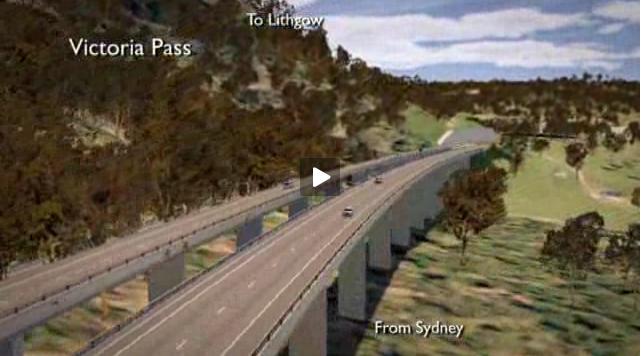 Artist’s scary impression…more trucking expressways. Artist’s scary impression…more trucking expressways.
.
Further Reading:
.
[1] ‘Springwood to Valley Heights Link Road – Traffic Modelling Report, 20120408, by GTA Consultants, ^http://bluemountainshaveyoursay.com.au/document/show/644
.
Tags: b-doubles, B-triples, Dog tired Fatigue Management, Great Western Highway, Riverside Refridgerated Transport crashRiverside Refridgerated Transport, RMS, Roads and Maritime Services, Roads and Traffic Authority, RTA, truck crash, trucking expressway
Posted in Blue Mountains (AU), Threats from Road Making | No Comments »
Add this post to Del.icio.us - Digg
Friday, September 20th, 2013

Last Monday 20130916, around 8.30am a native dingo was hit by a vehicle at 18 Mile Beach between Eurong and Dilli Village on Fraser Island. The Island is a World Heritage listed National Park and the wildlife is protected under the Nature Conservation Act.
Distressed witnesses stated the vehicle deliberately changed direction and aimed for the dingo which was struck. The vehicle continued to proceed at speed along the beach. It was described as an Orange Pajero.
The female lay suffering and howling in the sand with her mate close by licking her wounds, a Police Officer was called, who in turn contacted Rangers, sadly, the dingo had to be euthanised.
She appeared to be feeding. The fate of her pups is unknown.
This senseless act of cruelty will hardly cause a stir, there needs to be much stiffer penalties for injuring our wildlife. This is not acceptable.
The School holidays are here, a dingo casualty now, a child could be next.
If anyone has information please contact the local police or QPWS on (07) 4121 1800
Cheryl Bryant. Publicity Officer. Save Fraser Island Dingoes Inc.
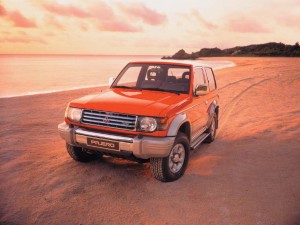 This is an old model Pajero, which may look like the killer’s car
This is an old model Pajero, which may look like the killer’s car
.
[Ed: It is past time that Fraser Island was completely closed to all tourism]
.
Tuesday, September 10th, 2013
 Windsor Downs Nature Reserve ablaze Windsor Downs Nature Reserve ablaze
Mis-identified by media as the ‘Marsden Park Fire’ ..”which started burning in a tip..”
[Source: Two Homes under threat in Sydney grass fire‘, 20130910, Australian Broadcasting Corporation,
^http://www.abc.net.au/news/2013-09-10/two-homes-under-threat-in-sydney-grass-fire/4948314]
.
Why did three wildfires start today in north western Sydney in protected reserves of Sydney’s remnant Cumberland Plains Woodland?
The fires all started around midday during high gusty wind conditions and unseasonally high temperatures. There was no lightning to speak of, so all three fires must have been caused by people.
Reckless burnoffs? Deliberately lit? By the same people? By developers wanting to undermine the Cumberland Plain Woodland and so extend their sprawl?
Whether it was bush arson or recklessness will be a matter for bushfire investigations which need to be mandatory for each and every wildfire. A forth wildfire at Winmalee in the nearby Blue Mountains (the ‘Hawkesbury Road Winmalee Fire‘) was purportedly a neglected hazard reduction burn – the Rural Fire Starters fuelling more work for themselves.
What did each wildfire cost – economic loss, infrastructure loss, productivity loss, direct firefighting costs, indirect costs, social costs? These are never measured or reported. The ecological costs are always ignored because ecology is not deemed to be valuable in our current society. How much death and harm has been infliced upon Windsor Downs Nature Reserve? Such value questions are beyond the thinking of our current society.
The RFS only prioritises saving human life and property. It thus has no different role than the NSW Fire Brigade. So the RFS should not exist. It only exists because the New South Wales government does not want to properly pay for firefighting. The RFS exists as unpaid volunteers so that the NSW government can divert hundreds of millions in taxes to other priorities it somehow considers to be more important.
Then the NSW government appeals for more volunteers to do its dirty work for free.
  . .
Whereas in New South Wales, a NSW Fire Brigage professional firefighter gets paid $29 an hour minimum. There will be many families that would dearly desire to receive that for their unpaid volunteering efforts.
.
“At Richmond Road and Bennett Road at Windsor, the RFS (New South Wales Rural Fire Service) says a grassfire could impact properties around George Street and the area of Bligh Park. The fire has crossed Garfield Road and is burning in the Windsor Downs Nature Reserve.”
[Sources: ‘Home lost as grass fires rage in Marsden Park and Windsor‘, 20130910, Daily Telegraph newspaper, Sydney, ^http://www.dailytelegraph.com.au/newslocal/the-hills/home-lost-as-grass-fires-rage-in-marsden-park-and-windsor/story-fngr8i1f-1226716140957; ‘Two Homes under threat in Sydney grass fire‘, 20130910, Australian Broadcasting Corporation, ^http://www.abc.net.au/news/2013-09-10/two-homes-under-threat-in-sydney-grass-fire/4948314]
.
The fire authorities have labelled this current fire the ‘Richmond Road Grass Fire‘, so will the records of the fire will be just scattered or erased? Today’s initial account of the fire on the official Rural Fire Service website reads thus :
“..A grass fire burning in the area of Richmond Road and Bennett Road at Windsor”. The fire is burning on both sides of George Street, South Windsor and both sides of Richmond Road. The fire is burning under strong northerly winds. An Emergency Alert telephone message has been sent to residents in these areas.
There is the potential for the fire to impact on properties around George Street and the area of Bligh Park. The fire has crossed Richmond Road and is now burning in the Windsor Downs Nature Reserve.”
.
To put this into geographic perspective, this is a presumed map of the affected area, in absence of RFS public transparency:
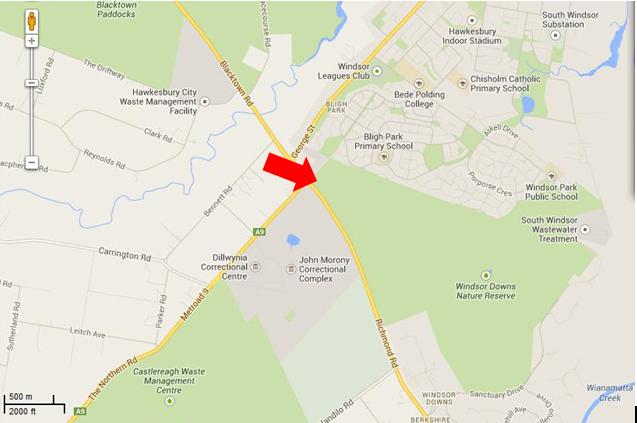
The presumed ignition of the Richmond Road Grass Fire
from Bennett Road, Windsor Downs
(outer north-western Sydney Metropolis)
[Source: Google Maps 2013]
.
<<Emergency warnings have now been issued for four bushfires in Sydney’s far north west, as temperatures in the city exceed 30 degrees with strong northerly winds.
The RFS says five firefighters have sustained smoke inhalation and two have received minor burns.
The fires are at Castlereagh, Richmond, Marsden Park, and Winmalee where one property is alight. At Richmond Road and Bennett Road at Windsor, RFS says a grassfire could impact properties around George Street and the area of Bligh Park. The fire has crossed Garfield Road and is burning in the Windsor Downs Nature Reserve. >>
.
[Ed: Garfield Road is in Riverstone, not Richmond, and is also quite distinct from the separate fire at Windsor Downs. Media reporting has been misleadingly false, overlapping and confused and likely due to naive junior desktop journalism. Worse is that the RFS report is equally confused. Fortunately no person died relying upon officialdom, but the wildlife count is never published].
.
.
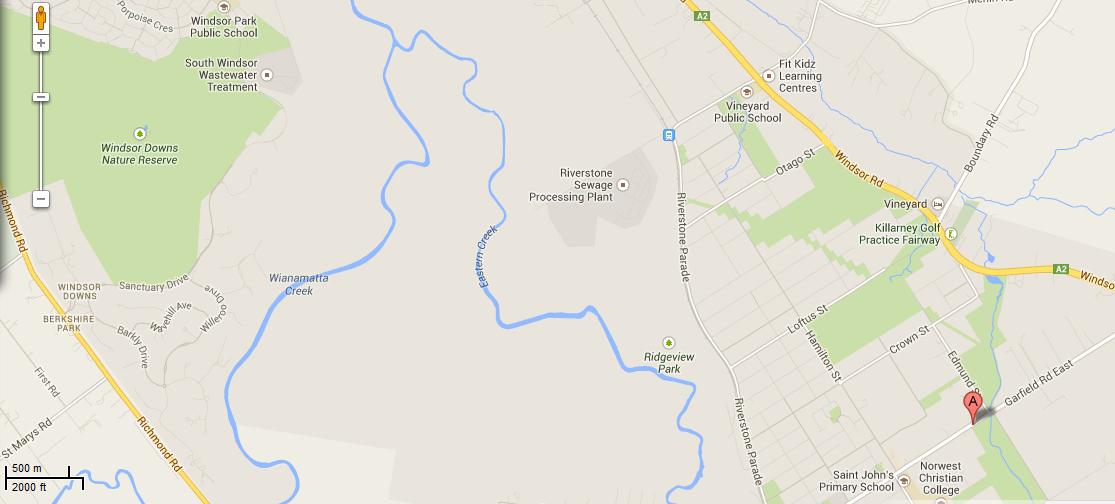 Map showing the juxtaposition of the Windsor Downs Nature Reserve over 3 km north west from Garfield Road in Riverstone.
Journalists have a lot to answer for when it comes to fact checking during emergencies.
[Source: Google Maps 2013, click image to enlarge]
Map showing the juxtaposition of the Windsor Downs Nature Reserve over 3 km north west from Garfield Road in Riverstone.
Journalists have a lot to answer for when it comes to fact checking during emergencies.
[Source: Google Maps 2013, click image to enlarge]
.
<< About 3,200 homes in the Richmond area have lost power and Endeavour Energy says it is working to get the supply back. The RFS says the fire is burning intensely under strong winds.
In Marsden Park, a grass fire is burning out of control and has crossed Garfield Road. While at Castlereagh, near Penrith, an emergency warning was issued around noon (AEST) for a fire which has destroyed a shed and burned 60 hectares. About 50 homes are thought to be under threat. The fire is burning around properties on Devlin Road and is moving towards homes on Nutt Road.
RFS Inspector Ben Shepherd says the conditions are difficult for firefighters.
RFS Inspector Ben Shepherd:
“I’m currently sitting on Nutt Road and the fire is moving quickly towards some homes in that area. The actual fire itself is putting up a huge column of smoke… and the wind continues to be quite strong. Because of that, that’s starting to send a couple of spot fires ahead of the main fire front itself.”
.
Local resident Kelly Elson has been evacuated from her home near the fire front. She says she first noticed the fire at about 10:30 this morning.
Windsor resident Troy Evans says that fire started in grass near his house on Bennett Road.
Windsor resident Troy Evans:
“So I went and told the firies ‘you better get a couple of trucks round here real quick’ which they did, luckily. They got the place under control then the wind turned and it’s just roared up through next door, jumped the road, it’s gone through the church, it’s over in the bus bay, it’s meant to have taken a couple of houses out in Bligh Park. Now it’s on it’s way into the jail, it’s just crazy.”
.
A very high fire danger alert has been issued for the Illawarra, Sydney, the Central Ranges, the Hunter, the north west and the north coast. More than 40 uncontained bushfires are currently burning across New South Wales.
Mr (RFS Commissioner Shane) Fitzsimmons says it is hot, dry and windy in most of the state today, with seven districts in very high fire danger. He says he is worried about the unseasonally warm start to spring on the back of a dry winter.
The RFS is urging property owners in semi-rural and rural areas to think about the conditions before they burn off land.”
.
[Ed: Fitzsimmons, why blame the weather and not the landholder who is accused of causing the ignition?]
.
[Source: ‘Homes under threat from bushfires at Castlereagh and Windsor in Sydney’s far north west’, 20130910, Australian Broadcasting Corporation, ^http://www.abc.net.au/news/2013-09-10/two-homes-under-threat-in-sydney-grass-fire/4948314]
.
[Ed: So the RFS is urging property owners in semi-rural and rural areas to think about the conditions before they burn off land.
Is this head office code for the known landholder who caused the fire and the RFS being too public servant skin timid to lay charges? So why is the landholder in Bennett Road not under arrest for suspected arson?]
.
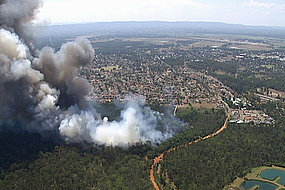
The fire inside the Windsor Downs Nature Reserve today
.
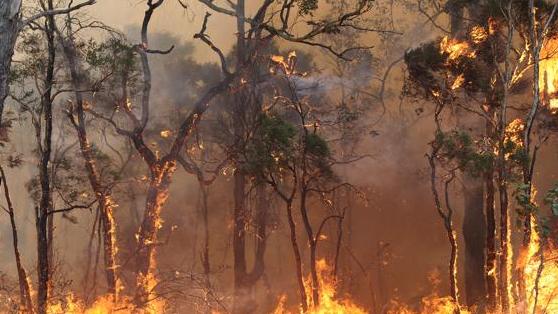 Windsor Downs native woodland habitat being burned alive
[Source: ‘Bushfires threaten Sydney’s western suburbs – NSW Rural Fire Service issues emergency warnings’, 20130910, Sydney Morning Herald newspaper (Sydney), ^http://www.smh.com.au/environment/bushfires-threaten-sydneys-western-suburbs-nsw-rural-fire-service-issues-emergency-warnings-20130910-2thnl.html] Windsor Downs native woodland habitat being burned alive
[Source: ‘Bushfires threaten Sydney’s western suburbs – NSW Rural Fire Service issues emergency warnings’, 20130910, Sydney Morning Herald newspaper (Sydney), ^http://www.smh.com.au/environment/bushfires-threaten-sydneys-western-suburbs-nsw-rural-fire-service-issues-emergency-warnings-20130910-2thnl.html]
.
.
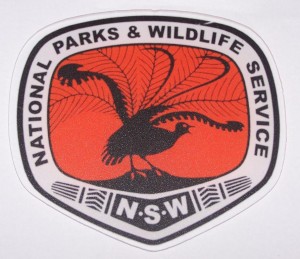 A liar bird of disinterested political masters A liar bird of disinterested political masters
.
http://www.youtube.com/watch?v=VktLOr4M46U
.
Cumberland Plain Woodland
.
Cumberland Plain Woodland including the Windsor Downs Nature Reserve, the nearby Castlereagh Nature Reserve and Agnes Banks Nature Reserve, all fall under the custodial management responsibility of the National Parks and Wildlife Service New South Wales – a state body.
Windsor Downs Nature Reserve features.. << an historic windmill and water tank protects a number of endangered plant communities and includes species such as the broad-leafed ironbark, grey box, scribbly gum, narrow-leafed angophora, pea flowers and a species of geebung.
Several bird species have been recorded – the red-capped and hooded robins, white-winged choughs, buff-rumped and yellow-tailed thornbills and the endangered regent honeyeater – which are usually found in the drier habitats of the central west slopes. >>
[Source: NSW Government, ^ http://www.environment.nsw.gov.au/NationalParks/parkHome.aspx?id=N0598]
.
Windsor Downs Nature Reserve is not just set aside for picnics. It is a remant ecological community with the fast disappearing Cumberland Plain Woodland. It is supposed to be protected.
.
<< The Cumberland Plain Woodland is the name for the distinct groupings of plants that occur on the clay soils derived from shale on the undulating Cumberland Plain in central New South Wales. The most commonly found trees in the woodland are Grey Box Eucalypts Eucalyptus moluccana, Forest Red Gums Eucalyptus tereticornis, Narrow-Leaved Ironbarks Eucalyptus crebra and Spotted Gum Eucalyptus maculata. A variety of other lesser-known eucalypts as well as shrubs, grasses and herbs are also found. It is the dominance of Grey Box and Forest Red Gum that makes the community distinctive.
In 1877 Cumberland Plain Woodland covered 107,000 hectares occupying approximately 30 per cent of the Sydney Basin. This community type was once widespread in the Plains but has been reduced to a few fragmented stands by human use for farming, industry and housing. Today less than six per cent remains in small fragments scattered across the western suburbs of Sydney, totalling only 6400 hectares. The remaining fragments occur in areas subject to intense pressure from urban development.
Although some areas occur within conservation reserves, this is in itself not sufficient to ensure the long-term survival of the community unless the factors threatening the integrity and survival of the community are eliminated.
The remaining stands of this ecological community are threatened by the spread of the Sydney suburban areas. Threats include clearance for agriculture, grazing, hobby and poultry farming, housing and other developments, invasion by exotic plants and increased nutrient loads due to fertiliser run-off from gardens and farmland, dumped refuse or sewer discharge.>>
[Ed: and of course ‘bushfire’, which the government does not like to include out of embarassment of neglect, yet which is causes the most devastating impact].
.
[Source: ‘Woodlands vanishing from Sydney’s outskirts’, by Environment Australia, Australian Government, ^http://www.environment.gov.au/biodiversity/threatened/publications/cumberland.html]
.
Cumberland Plain Woodland in the Sydney Basin Bioregion – proposed critically endangered ecological community listing
.
<< The NSW Scientific Committee, established by the Threatened Species Conservation Act, has made a Preliminary Determination to support a proposal to list the Cumberland Plain Woodland in the Sydney Basin Bioregion as a CRITICALLY ENDANGERED ECOLOGICAL COMMUNITY on Part 2 of Schedule 1A of the Act and as a consequence, to omit reference to Cumberland Plain Woodland from Part 3 of Schedule 1 (Endangered Ecological Communities) of the Act. The listing of Critically Endangered Ecological Communities is provided for by Part 2 of the Act.
The Scientific Committee has found that:
1. Cumberland Plain Woodland was listed as an Endangered Ecological Community under the Threatened Species Conservation Act 1995 in June 1997 (NSW Scientific Committee 1997). Since this listing, a large volume of new data and analyses have become available. In addition, a nomination to change the status of Cumberland Woodland to Critically Endangered status has been received. This Determination addresses additional information now available in accordance with current listing criteria under the Threatened Species Conservation Regulation 2002.
2. Cumberland Plain Woodland is the name given to the ecological community in the Sydney Basin bioregion associated with clay soils derived from Wianamatta Group geology, or more rarely alluvial substrates, on the Cumberland Plain, a rainshadow area to the west of Sydney’s Central Business District. >>
<<..high frequencies of fires may result where fragmentation increases the interface between urban areas and bushland, as this results in increased arson, car dumping, planned fuel-reduction fires and accidental ignitions.
High fire frequencies are associated with reduced diversity of native plant species in Cumberland Plain Woodland (Watson 2005). ‘High frequency fire resulting in disruption of life cycle processes in plants and animals and loss of vegetation structure and composition’ is listed as a Key Threatening Process under the Threatened Species Conservation Act 1995.
The season of fire, which may be altered as a consequence of hazard reduction fires, may also influence the species composition of the grassy woodland understorey (Knox & Clarke 2006; Benson & von Richter 2008).
Disruption of ecological processes associated with alteration of fire regimes contributes to a very large reduction in ecological function of the community. >>
.
[Source: ‘NSW Scientific Committee – preliminary determination’, Australian Government, ^http://www.environment.nsw.gov.au/determinations/cumberlandplainpd.htm]
.
But wait, there is a:
which reads…

.
The official Fire Management Strategy has been conveniently removed from public access on the National Parks and Wildlife Service (NPWS) website.
However, the following extracts from the similar and nearby Agnes Banks Nature Reserve are instructive as to the approach taken by NPWS management on all nature reserves across the Sydney Basin that comprise remnant ecology of the Cumberland Plain Woodland.
.
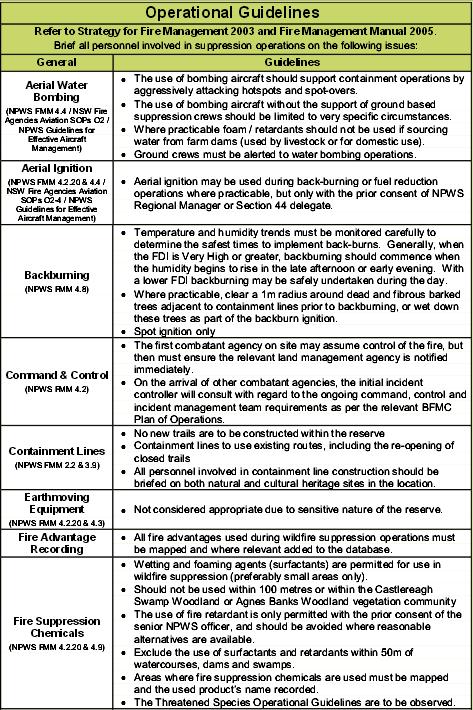
.
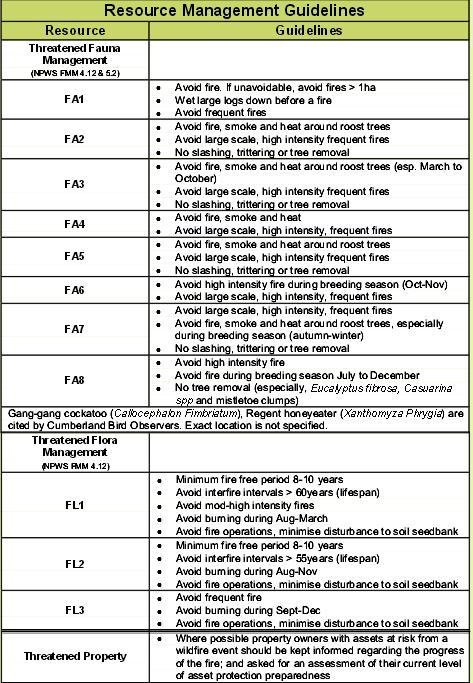
Source: ‘Agnes Banks Nature Reserve Fire Management Strategy, 2006, (last modified 20070323), NPWS (NSW), NSW Government, ^http://www.environment.nsw.gov.au/resources/parks/06354AgnesBanksFMS.pdf]
.
[Ed: Disturbingly noted is that the NPWS ‘ecological’ policy is that it ok to burn these woodland reserves every 8 years. So government care factor about bushfire impact?]
.
<<..little research has been undertaken into fire management prescriptions for Cumberland Plain woodland and forest associations when compared to the nearby Hawkesbury sandstone communities.>>
~ Windsor Downs Nature Reserve et al. Plan of Management (NPWS 1999,p.18)
.
The official Bureau of Meteorology had in the days prior, forecast strong gusty north westerly winds for the western Sydney region for both yesterday and today, following a few days of calm winds. The Rural Fire Service would have been well aware of this forecast, the extreme bushfire conditions that this posed and the considerable escalated risk of damaging wildlfires.
The subsequent actual weather observations for Richmond are telling. Look at the 10th. The arsonists know what they are doing.
.
 [Source: Australian Bureau of Meteorology,
^http://www.bom.gov.au/climate/dwo/201309/html/IDCJDW2119.201309.shtml] [Source: Australian Bureau of Meteorology,
^http://www.bom.gov.au/climate/dwo/201309/html/IDCJDW2119.201309.shtml]
.
Reliant mainly on public calls to ‘000’, fire trucks and road-routed volunteers, the RFS continues to be grossly under-equipped to handle wildlfires in a timely and effective manner, which increasingly to many is unacceptable to bushfire prone communities in this now 21st Century.
.
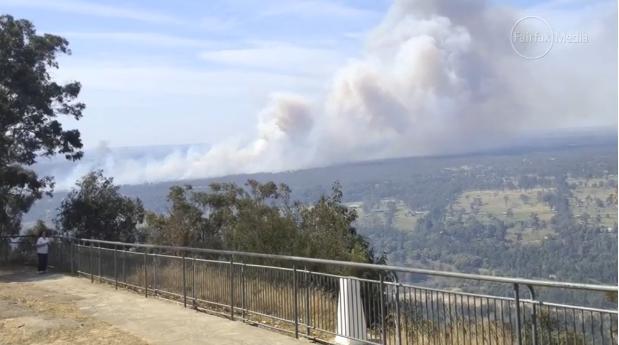 Windsor Downs Nature Reserve ablaze (from Hawkesbury Lookout) Windsor Downs Nature Reserve ablaze (from Hawkesbury Lookout)
[Source: ‘Hazard reduction burn started major Sydney bushfire’, by Megan Levy, Sydney Morning Herald, 20130913,
^http://www.smh.com.au/nsw/hazard-reduction-burn-started-major-sydney-bushfire-20130913-2tois.html]
.
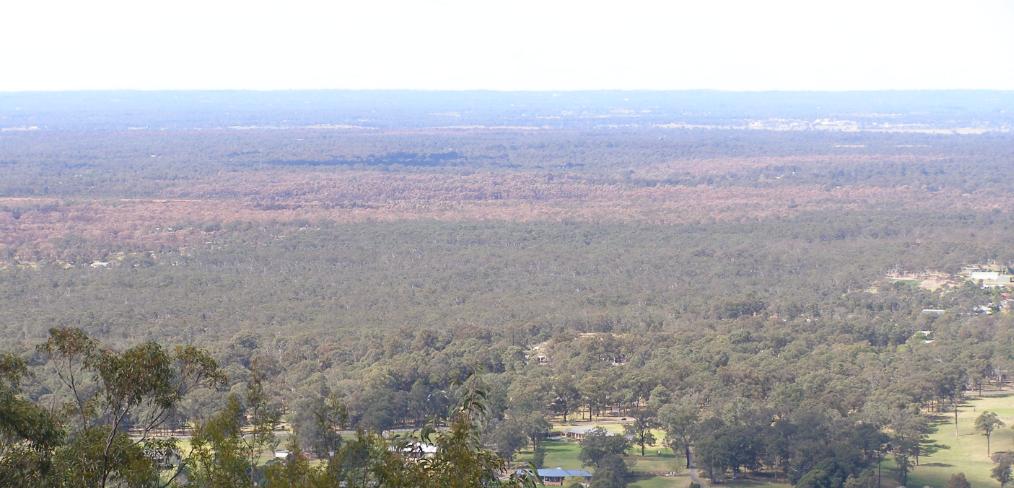 Windsor Downs Nature Reserve incinerated (see browned woodland canopy in centre of photograph)
[Photo taken by Editor from Hawkesbury Lookout looking north east on 20130921, photo © under ^Creative Commons]
Click image to enlarge Windsor Downs Nature Reserve incinerated (see browned woodland canopy in centre of photograph)
[Photo taken by Editor from Hawkesbury Lookout looking north east on 20130921, photo © under ^Creative Commons]
Click image to enlarge
.
Steadily year on year, the last bushland reserves that provide critical remnant habitat around Sydney are being destroyed. Before long the only bushland will be that in suburban gardens, and the wildlife will be finally made regionally extinct.
.
 Critically Endangered Regent Honeyeater
(Anthochaera phrygia)
A native bird species dependant upon a disappearing habitat
Humans obliterated its habitat for logging, farming and housing
Then we constrained it to a few nature reserves like Windsor Downs,
Then we burnt the reserve. Critically Endangered Regent Honeyeater
(Anthochaera phrygia)
A native bird species dependant upon a disappearing habitat
Humans obliterated its habitat for logging, farming and housing
Then we constrained it to a few nature reserves like Windsor Downs,
Then we burnt the reserve.
.
.
.
Further Reading:
.
[1] ‘NSW Scientific Committee – preliminary determination‘, Australian Government, ^http://www.environment.nsw.gov.au/determinations/cumberlandplainpd.htm
.
[2] ‘Castlereagh, Agnes Banks and Windsor Downs Nature Reserves – Plan of Management‘, NSW Government, ^http://www.environment.nsw.gov.au/resources/parks/pomfinalagnescastlereagh.pdf
.
Footnote
.
‘Hunt for arsonist over western Sydney bushfire’
[Source: ‘Hunt for arsonist over western Sydney bushfire’, Friday 20130913, ABC, ^http://www.abc.net.au/news/2013-09-13/hunt-for-arsonist-over-western-sydney-bushfire/4956022]
.
<<Authorities say they believe a fire that destroyed a home at Marsden Park in Sydney’s west on Tuesday was deliberately lit. Investigators have also not ruled out that an arsonist may have caused a blaze at nearby Londonderry. Police are now calling for witnesses to help identify the person responsible for sparking the Marsden Park fire.
Assistant Commissioner Alan Clarke says it is believed the fire began on Grange Avenue just after midday on Tuesday.
.
Alan Clarke:
.
“There are crime scene indicators at the source of that fire that would lead us to suspect arson activity. I really can’t tell you more than that at the moment. It’s mainly our crime scene indicators and forensic evidence that would have us raise that suspicion. If anyone has information, if anyone saw any suspicious activity in or around that fire location, any part of it… please pass that information on for the benefit of police.”
.
Rural Fire Service Deputy Commissioner Rob Rogers has confirmed another serious fire at Winmalee, in the lower Blue Mountains, was caused by a hazard reduction burn conducted by the NSW National Parks and Wildlife Service.
.
Rob Rogers:
“That fire was burn on the weekend, it was patrolled on Monday, there was smouldering activity. That fire then jumped containment lines on the Tuesday and became an active fire. The winds on that day did exceed forecast and they were around 90 kilometres an hour, and obviously that tested the control lines on that hazard reduction and it did escape. In these strong winds branches came off trees, hit the powerlines, the powerlines were brought down, they ignited grass in that area and that was the cause of that fire. You would have to obviously be suspicious that it did come from the hazard reduction, given that it was in a very close proximity to it.”
.
Investigators have found a fourth fire that began on Richmond Road at Windsor Downs was sparked by downed power lines. The investigation into a fire that closed the M1 motorway, formerly known as the F3, north of Sydney yesterday is continuing, with another hazard reduction burn the suspected cause. Assistant Commissioner Alan Clarke has warned those that deliberately light fires or cause them through negligence will be caught.
.
Alan Clarke:
“Last year we arrested 87 individuals and they faced charges in respect of bushfire and fire related activity for 117 charges. We know this year again we will be putting offenders before the court. It’s sad but it’s true.”
.
Tags: A liar bird of disinterested political masters, Agnes Banks Nature Reserve, Castlereagh Nature Reserve, Cumberland Plain Woodland, Hawkesbury Road Winmalee Fire, Marsden Park Fire, NPWS, NSW Fire Brigade, NSW National Parks and Wildlife Service, Retained Firefighter, Richmond Road Grass Fire, Rural Fire Starters, Windsor Downs Nature Reserve
Posted in Birds (Australian), Critically Endangered Wildlife (CR), Threats from Bushfire | No Comments »
Add this post to Del.icio.us - Digg
Tuesday, September 3rd, 2013
 Offering to their Fire God Supreme Offering to their Fire God Supreme
.
When the wind is calm, a special cult emerges that yearns the desire for fire, the Rural Fire Starters (RFS).
Playing with fire in rural Australia is like messing with the Devil. The consequence can be catastrophic – death, maiming, economic loss. Each quite evil.
Arson is criminal. Arson is not just lighting fires to buildings. It is lighting fires that causes destruction. Arson attracts either a $14,000 fine or a long jail term.
Calm wind triggers a hazard reduction burn offering to their Fire God Supreme.
.
 RFS/NPWS: “Burning doesn’t hurt. Burning is good for ecology.”
“Set fire to others as you would never under Hades have them do unto you.” RFS/NPWS: “Burning doesn’t hurt. Burning is good for ecology.”
“Set fire to others as you would never under Hades have them do unto you.”
.
The ritual prescribes setting fire to bushland and wildlife habitat, where the flames reach the same height as a wildfire. Thousands of hectares are burnt every year as demanded by the cult’s ritual.

.
To outsiders, the justification for the HR ritual bush arson is to prevent wildfires.
 Any growth after a firestorm means regeneration, extrapolated to ‘killing is OK ‘.
[Source: ‘New life for the state’s north-east after a trial by fire’, 20030405,
Photo at Victoria’s Mount Beauty by Jason South,
^http://www.theage.com.au/articles/2003/04/04/1048962933714.html] Any growth after a firestorm means regeneration, extrapolated to ‘killing is OK ‘.
[Source: ‘New life for the state’s north-east after a trial by fire’, 20030405,
Photo at Victoria’s Mount Beauty by Jason South,
^http://www.theage.com.au/articles/2003/04/04/1048962933714.html]
.
RFS reality is that when wildfires do occur, often started by people or else ignitions in bushland left to burn and spread for hours and days, they become wildfires, so same outcome regardless: Death to the last of Ecology.
RFS reality perpetuates the colonial destruction mindset of the fragmented vital ecology that remain in New South Wales and Australia.
On the radio today, the RFS media spokesperson declared that the hazard reduction focus was on a wild area that hadn’ been burnt for some time. This implied that the RFS mindset about wildlife habitat is that it is only singularly a threat. If bushland and forest has not been burnt for some time then according to the bushphobic cult, it must be burnt. Dense undergrowth in the eyes of the RFS is evil. May it dare exist anywhere in New South Wales, burn it save it catch fire.
.
RFS firefighter convicted of arson
.
 RFS Firefighter, Joshua Staples
Finally jailed this week for lighting blazes in western Sydney
RFS arsonists look like anyone in the street
Photo by John Grainger, Daily Telegraph (Sydney newspaper) RFS Firefighter, Joshua Staples
Finally jailed this week for lighting blazes in western Sydney
RFS arsonists look like anyone in the street
Photo by John Grainger, Daily Telegraph (Sydney newspaper)
.
<< A Rural Fire Service volunteer who lit a string of fires before helping to put them out will spend at least a year behind bars. (Ed: not enough)
Magistrate Michelle Goodwin today sentenced 20-year-old Joshua Staples to 18 months’ jail with a non-parole period of one year.
His mother, Jennifer Carter, grinned and called out “You right mate?” as her son was handcuffed and led from Sydney’s Downing Centre Local Court.
The evidence by Staples’ mother was rejected as a lie, who had told the court any number of family or friends could have been driving the cars spotted at the scenes of the fires.
Staples, from Badgerys Creek, was convicted of deliberately starting multiple grass and bin fires at Bringelly, Badgerys Creek and Greendale in January 2011.
In several instances, Staples then joined his RFS colleagues and helped extinguish the blazes, the court heard.
His lawyer had pushed for a part-time or non-custodial sentence.
“The offences are out of character for him, he’s unlikely to reoffend, and has positive prospects for rehabilitation,” Michael Coroneous told the court. Mr Coroneous said his client had only recently turned 18 when he lit the fires, and his immaturity should be considered. “He was one month and 21 days over the cut-off mark,” he said.
.
(Ed: Arsonist Lawyers will say anything for their clients)
.
Magistrate Goodwin said a psychiatrist’s report showed there were “no psychiatric issues apparent” but “the offender still maintains his innocence. It is therefore difficult to assess any prospects for rehabilitation,” she said before handing down her sentence. I am firmly of the view that the only appropriate sentence … will be a sentence of full-time custody.”
Staples will serve nine terms of 18 months concurrently.
His grandmother Veletta Heron, who crucially told Staples’ trial that her grandson had broken down at her kitchen table and confessed to lighting the fires, was not in court to see him sentenced. In the hearing in January, Ms Heron gad said that she was trying to help her grandson with legal paperwork after he was charged, and asked him to explain police surveillance photos that showed his car near the site of a blaze.
“He was very quiet and I looked up and he was crying,” Mrs Heron said at the hearing. “I don’t think I’ve ever seen Josh cry as much. He was red and had tears running down his face. “I said ‘what’s the matter?’ and he said ‘I did them’. “I stopped for a moment and I tried to think what to say and I said ‘what did you do, Josh?’ and he said ‘the fires’.”
Staples broke down during his evidence and told the court his grandmother was lying. >>
.
[Sources: ‘Jail for firefighter turned arsonist‘, 20130902, by AAP, ^http://www.theaustralian.com.au/news/nation/jail-for-firefighter-turned-arsonist/story-e6frg6nf-1226708936041; ‘RFS volunteer found guilty of lighting fires‘, 20130516, by Stephanie Gardiner, Goulburn Post, ^http://www.goulburnpost.com.au/story/1505961/rfs-volunteer-found-guilty-of-lighting-fires/http://www.goulburnpost.com.au/story/1505961/rfs-volunteer-found-guilty-of-lighting-fires/]
.
 Everyone for themselves Everyone for themselves
.
“During the past 10,000 years, during the Holocene, Australia’s (tectonic) global position has changed very little, but there have been enormous changes in its flora and fauna. These changes have occurred since the first people arrived in Australia, but most dramatics have happened during the last 200 years, since the European settlement (invasion) of Australia.
During this very short period of Australia’s history, an estimated 20 billion trees have been removed (decimated) from 70% of the continent for agriculture, and dozens of plants and animals have been introduced and become wild. Whole ecosystems have been affected and many native plants and animals have become extinct.”
“..During the last 200 years land has been overstocked and overcropped, damaging fragile soils, increasing erosion and causing choking dust storms. Limted water resourses have been mismanaged, leading to a rising tide of underground salt and silting of waterways. Fertilisers, pesticides, herbicides and other chemicals have poisoned soils and waterways.
Traditional European farming practices were not sustainable in the new homeland and native wildlife and habitats suffered badly.
At least 40 Australian frogs, 120 reptiles, 200 birds and mammals, 35 species of freshwater fish and more than 3000 plants species have become extinct – the worst record for sany continent.”
[Source: ‘The Evolution of Australia: 110 million years of change’, 2002, Australian Museum Trust, (printed book), pp.59, 61]
.
 Native Brushtailed Possum badly burnt (paws included) in bushfire because it had nowhere to go up its Eucalypt
“DEC officers have since reported that most of the animals they have come across are dead.”
[Source: Furries badly burnt in Lake Clifton blaze’, 20110112,
^http://www.watoday.com.au/wa-news/furries-badly-burnt-in-lake-clifton-blaze-20110112-19nge.html] Native Brushtailed Possum badly burnt (paws included) in bushfire because it had nowhere to go up its Eucalypt
“DEC officers have since reported that most of the animals they have come across are dead.”
[Source: Furries badly burnt in Lake Clifton blaze’, 20110112,
^http://www.watoday.com.au/wa-news/furries-badly-burnt-in-lake-clifton-blaze-20110112-19nge.html]
.
Ed: Want a definition of evil?
Watch wildlife burn to death in a bushfire,
sickly “controlled” or “prescribed” or otherwise.
.
Fire is a key threatening process that locally and regionally causes fauna extinctions, especially to territorial mammals that cannot relocate. But the RFS does not employ zoologists or ecologists on the side of fauna. They would only question the cult’s bizarre premise – ‘fire is good for wildlife’.
To unto others?
 So volunteers do as they are told by the RFS and NPWS command
to go set fire to the bush, but they know not what they do.
Wildlife burn just like humans. Slow moving Echidna’s, Wombats, what of them?
So volunteers do as they are told by the RFS and NPWS command
to go set fire to the bush, but they know not what they do.
Wildlife burn just like humans. Slow moving Echidna’s, Wombats, what of them?
.
The RFS bushphobic cult has usurped all logical decision making, and all independent thought. The cult prescribes that if native habitat has not been burnt for years, it must be deemed a threat and so must be burnt, and so coloured red on the To Burn map. Such is the unquestioned extent of cult mindset that it harks to the ancient and backward ‘Trial by Ordeal’ of drowning witches. If the accused drowned she was innocent, but if she didn’t drown then she must be a witch and so punished by being burnt to death.
.
 “And if anyone’s name was not found written in the book of life,
he was thrown into the lake of fire.”
~ The Bible, Revelation 20:15 “And if anyone’s name was not found written in the book of life,
he was thrown into the lake of fire.”
~ The Bible, Revelation 20:15
.
The weak underbelly of the cult is that in the event of a real wildfire, Rural Fire Starters are as wholly incompetent and ill equipped as a Dad’s Army.
Rural Fire Starters are:
- Incompetent and ill equipped to detect ignitions in a timely manner
- Incompetent and ill equipped to immediately respond to ignitions in a timely manner
- Incompetent and ill equipped to suppress ignitions from becoming wildfires
.
 “Who are you then?”
“I am part of that power which eternally wills evil and eternally works good.”
~ Johann Wolfgang von Goethe.
“Who are you then?”
“I am part of that power which eternally wills evil and eternally works good.”
~ Johann Wolfgang von Goethe.
.
Like the exclusive brethren, the absolutism of the Rural Fire Starting cult prevails. Involvement is entirely religious and wholly submissive to government cost saving policy.
Here, we supply the uniforms and equipment so that you may go forth and do RFS dirty work…
.
 Anyone can set fire to Nature
New members welcome
Our indoctrination demands complete media silence, no pay, no questioning.
Anyone can set fire to Nature
New members welcome
Our indoctrination demands complete media silence, no pay, no questioning.
.
.
 “The thief comes only to steal and kill and destroy.
I came that they may have life and have it abundantly.”
~ The Bible, John 10:10
“The thief comes only to steal and kill and destroy.
I came that they may have life and have it abundantly.”
~ The Bible, John 10:10
.
|
|
 An out of control petrol tanker semi-trailer speeding 80kph down Mona Vale Road rolls and explodes, burning two motorists to death.
An out of control petrol tanker semi-trailer speeding 80kph down Mona Vale Road rolls and explodes, burning two motorists to death. Safety First
Residents of the roadside community of Woodford in the Blue Mountains west of Sydney protest over losing their pedestrian crossing so that trucks can cruise nudging 90kph through their village. [Photo by Jodi McConaghy, 20130608]
Safety First
Residents of the roadside community of Woodford in the Blue Mountains west of Sydney protest over losing their pedestrian crossing so that trucks can cruise nudging 90kph through their village. [Photo by Jodi McConaghy, 20130608]
 The Mona Vale Road trucking experience
Coming to a roadside community near you.
The Mona Vale Road trucking experience
Coming to a roadside community near you.
 A toxic mix of 18,000 litres of petrol and fire retardant polluting surrounding waterways.
Without trucks Australia may stop, but with the current trucking mentality people are dying, like the two men burnt to death in the above car.
(Source: ABC News)
A toxic mix of 18,000 litres of petrol and fire retardant polluting surrounding waterways.
Without trucks Australia may stop, but with the current trucking mentality people are dying, like the two men burnt to death in the above car.
(Source: ABC News)
 With Trucks Australia Stops
With Trucks Australia Stops





























































